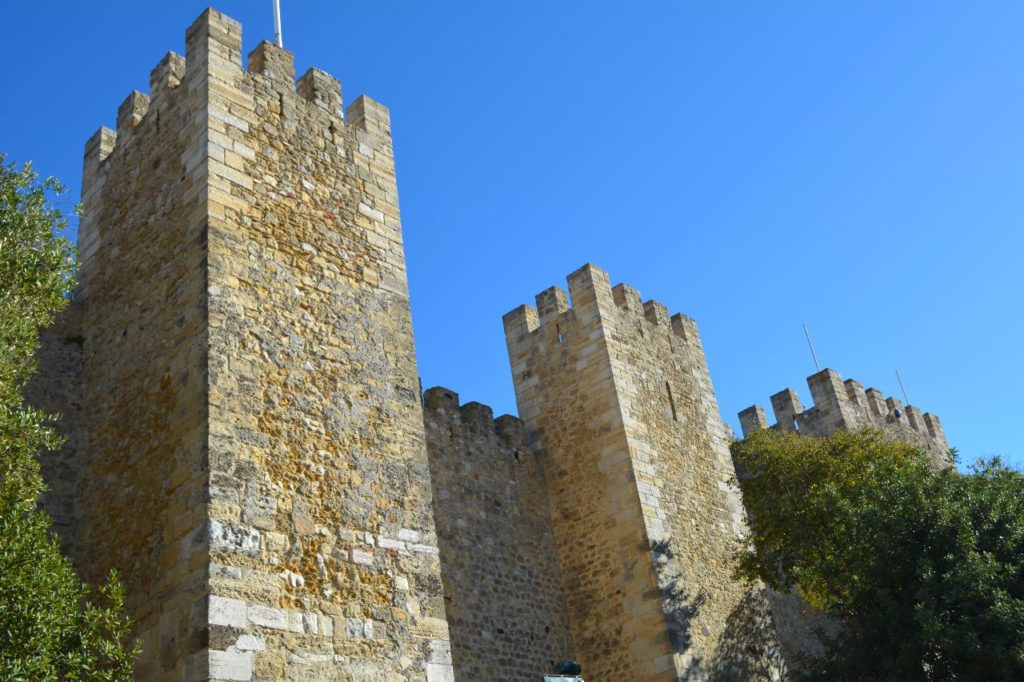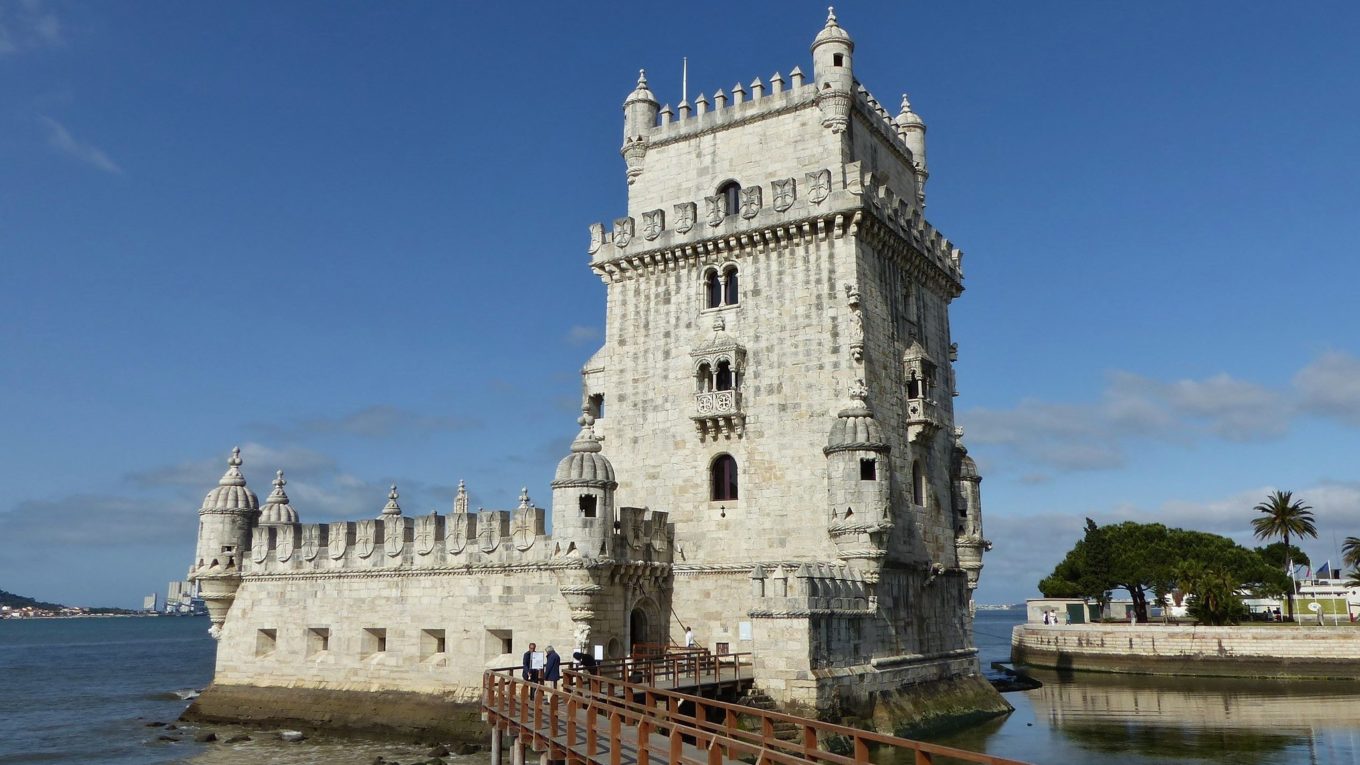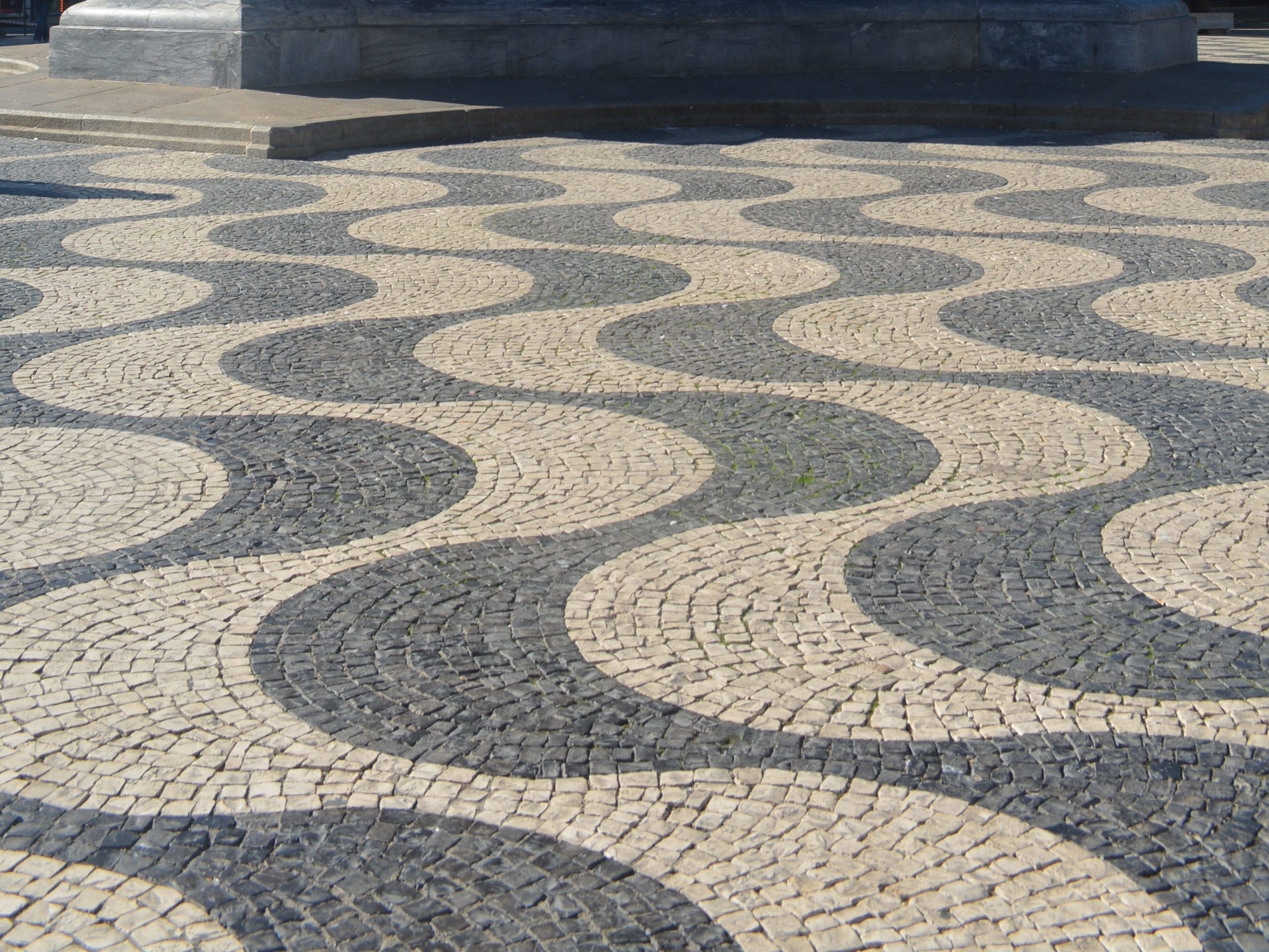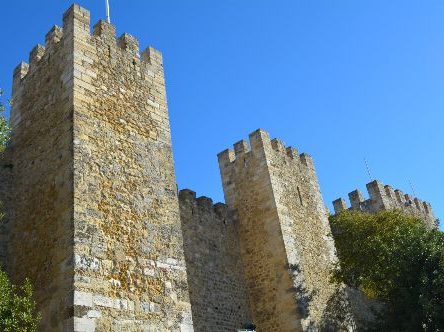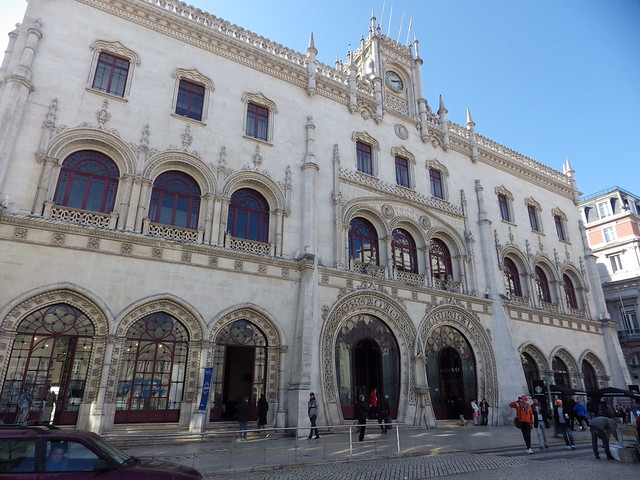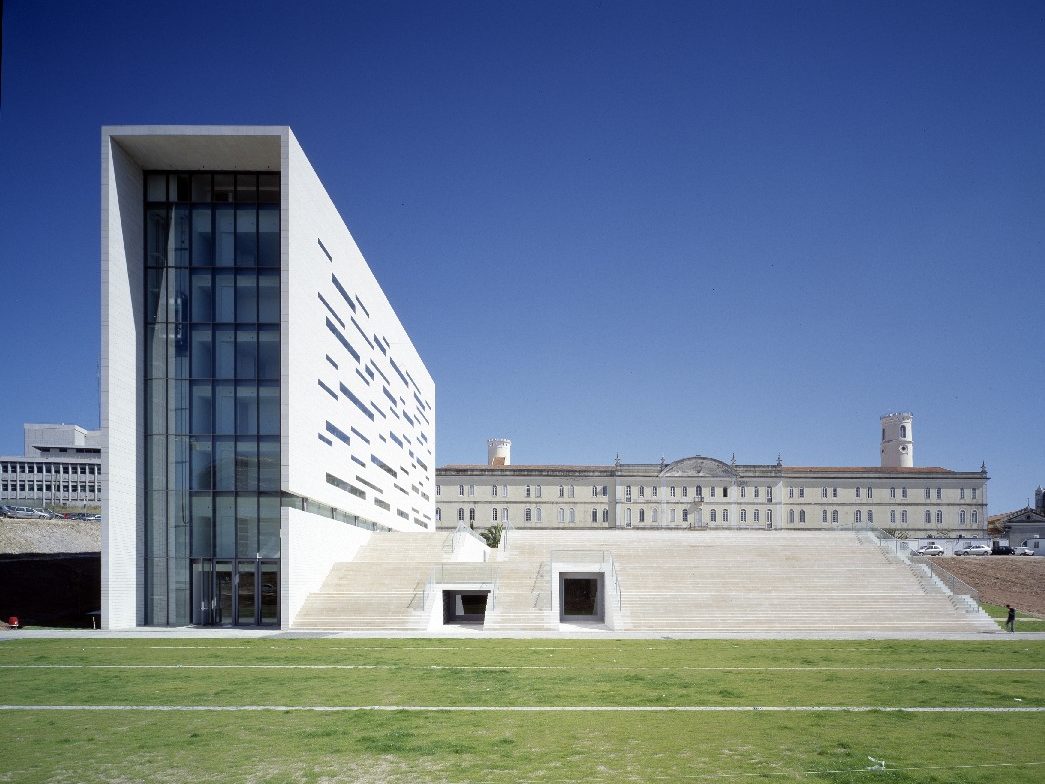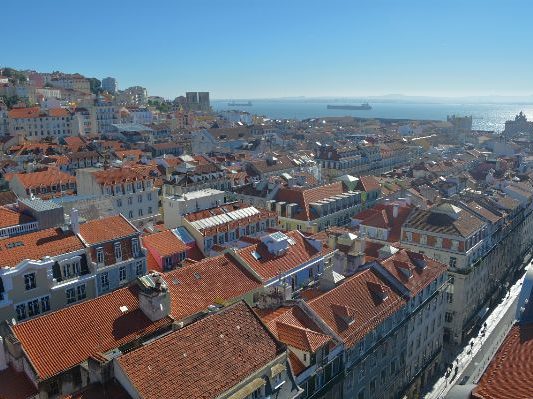Architecture of Lisbon, Portugal
Lisbon is the Capital of Portugal and the nation’s largest city. It sits at the mouth of the mighty Tagus River, and it has direct access to the Atlantic Ocean. It is the westernmost capital in mainland Europe and it has always had an important relationship with the sea. Lisbon thrived during the Age of Discovery, when works of Gothic Architecture in the Manueline Style were built throughout the city. Portuguese Discoverers like Henry the Navigator and Vasco da Gama were sailing to new uncharted parts of the earth, and bringing back valuable resources like coffee, tobacco, spices, and gold.
The city suffered a terrible tragedy when the Great Lisbon Earthquake of 1755 brought widespread destruction. After the disaster, the great rebuild of Lisbon began. The city center was completely rebuilt in a grided series of streets with large squares connected by wide boulevards. Despite the Lisbon Earthquake, and the breakup of the Portuguese Empire, the city still managed to rebuild and become one of Europe’s most visited capital cities. Below is a list of the greatest works of architecture in Lisbon and a look at the various building styles that can be found throughout the city.
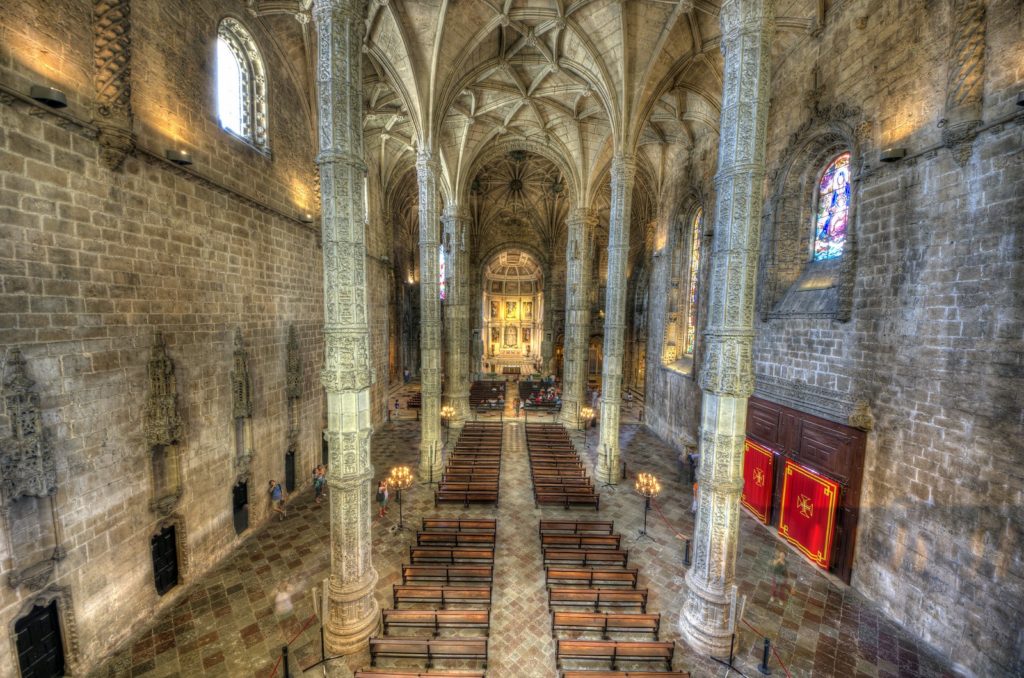
Photo by Armin Rodler from Wikimedia Commons
Map of Lisbon

Map of Lisbon highlighting some of the city’s main attractions.
1. Praça do Comércio
2. Rua Augusta
3. São Jorge Castle & Surrounding Hilltop
Table of Contents
Use these buttons to navigate to different sections of the article
History of Lisbon
Unifying Elements in Lisbon Architecture
Manueline Gothic
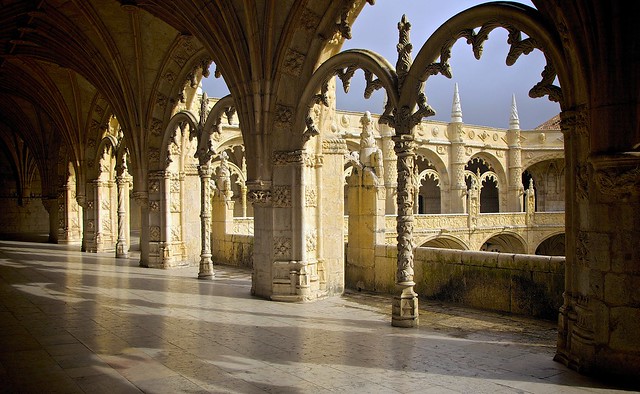
One of several styles of architecture found within Lisbon, Manueline is a form of Gothic Architecture that gets its name from King Manuel I. This style was popular during Portugal’s rise as a maritime power in the Age of Discovery. Thanks to the skill of Portuguese explorers, dozens of colonies were set up throughout South America, Africa, and Asia. Manueline Architecture attempts to embody the Age of Discovery by using various nautical themes. Sailing knots, ropes, navigation tools, and marine life are all depicted in various Manueline Buildings. The cloisters of Jerónimos Monastery are regarded as some of the most impressive examples of Manueline Architecture in Lisbon.
Pombaline Architecture
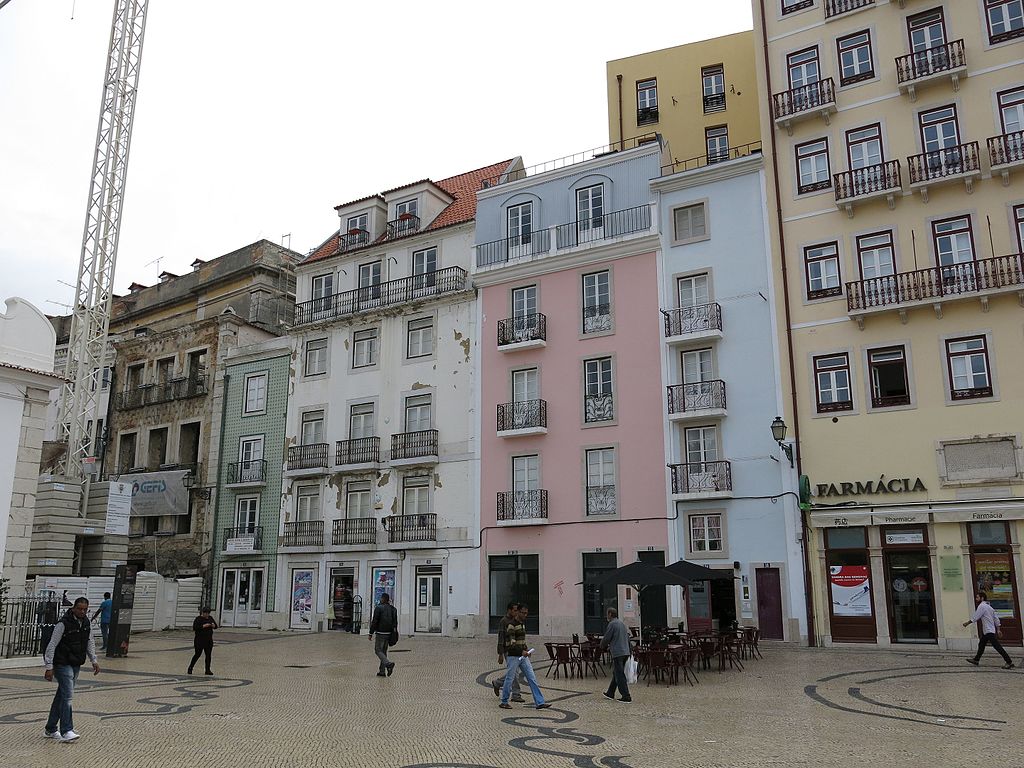
Another building style that is prevalent throughout Lisbon is Pombaline Architecture. All Pombaline buildings date from after 1755, when the Great Lisbon Earthquake destroyed most of the city’s historic center. The rebuild of Lisbon took place after the quake, and it was executed by Sebastião José de Carvalho e Melo, the 1st Marquis of Pombal. He chose several military engineers to help design a new plan for Lisbon. Their new plan centered around buildings that could be made quickly, and cheaply. These new structures were all built from the same mold: a boxy, square exterior with uniform windows and balconies. This new static and unvarying building form is known as the Pombaline Style, named for the Marquis of Pombal.
Azulejo Tiles

Azulejo Tiles are a form of ceramic tile that can be found throughout the architecture of Lisbon. Typically colored with shapes of blue and white, Azulejo tiles often feature geometric patterns. Sometimes, like in the image above at the Carlos Lopes Pavillion, the tiles can be formed to make large murals. Azulejo Tiles are found throughout Portugal, and in the heart of Lisbon is the famous Azulejo Tile Museum. It focuses on the varying forms of the tiles, and how they have been a part of Portuguese culture for centuries.
Black & White Patterned Paving
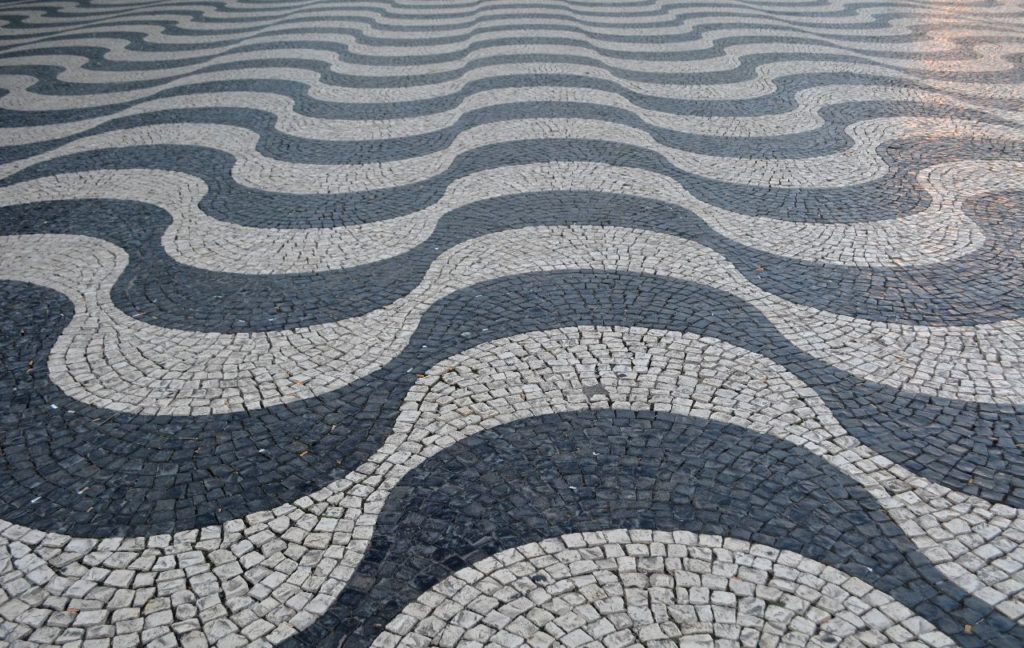
Another architectural characteristic that ties all of Lisbon together is the paving of the streets and sidewalks. Much of the city’s historic neighborhoods are completely paved with distinct black and white patterned stones. Many of the city’s great public spaces such as Praça do Municipio and the Rua Augusta are completely covered with these same stone pavers. The image above shows a typical pattern from Rossio Square that features undulating curves. Although there are a variety of patterns throughout the city, all of them are cohesive in color and concept, and they combine to create some of the greatest hardscape spaces in all of Europe.
The Pombaline Plan
The Pombaline Plan was drawn up by a few military engineers who were working with the First Marquis of Pombal. The gridded city plan was designed to completely reinvent the historic center of Lisbon after it was destroyed in the 1755 earthquake. While the modern plan of Lisbon varies slightly from the original design, the overall Pombaline plan was implemented successfully, and it’s still very apparent today.
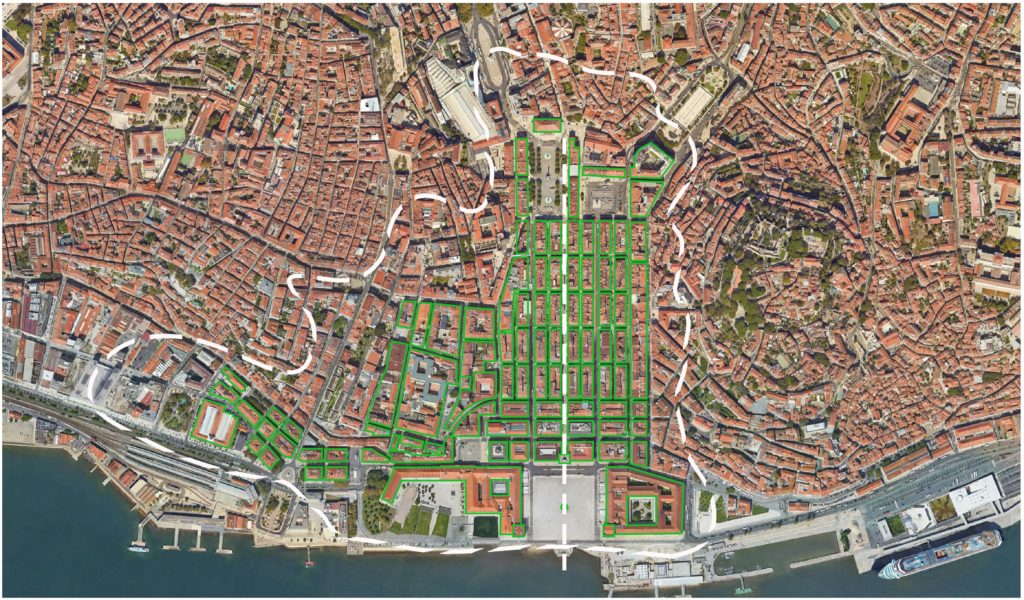
The Pomaline Plan contains a central axis that is known as the Rua Augusta. This pedestrian-only street is indicated by the dashed line in the image above. The approximate area of destruction from the Great Lisbon Earthquake is also shown with a dashed line.
Gothic & Medieval Architecture in Lisbon
The neighborhoods of Belém and Alfama managed to survive the destruction of the earthquake in 1755, and that’s where you can find some of Lisbon’s oldest structures. Some of these buildings, such as São Jorge Castle date all the way back to the origins of Lisbon. While others such as the Tower of Belém and Jerónimos Monastery date to the rise of Portugal in the Age of Discovery. These older monuments were built using some of Europe’s earliest building forms, such as Romanesque and Gothic Architecture. Lisbon was one of the most powerful cities in Europe by the 1500s, and taxes on trade with its overseas colonies led to a Golden Age that saw the completion of many of the city’s greatest works of architecture.
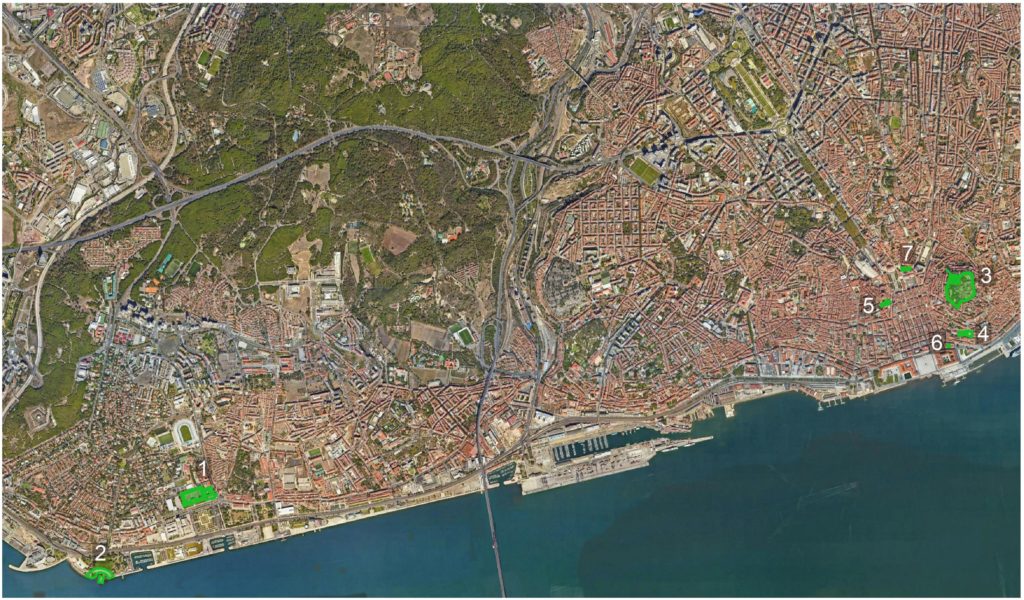
Map of Lisbon highlighting the most notable works of Gothic & Medieval Architecture within the city.
1. Jerónimos Monastery

Jerónimos Monastery began as a humble chapel that was used by sailors for prayer before they ventured out to sea. By order of the Portuguese King Manuel I, the monastery was greatly expanded. The project was financed by the incredible tax revenue that was brought in by the taxation of spices and other goods from Portugal’s colonies. The majority of the complex is built in the Manueline Gothic Style. The main church on the site is known as the Church of Santa Maria, and it is connected to several other wings. From the exterior, you can see all of the typical Gothic elements, such as pointed arches, pinnacles & spires, and tall stained-glass windows.

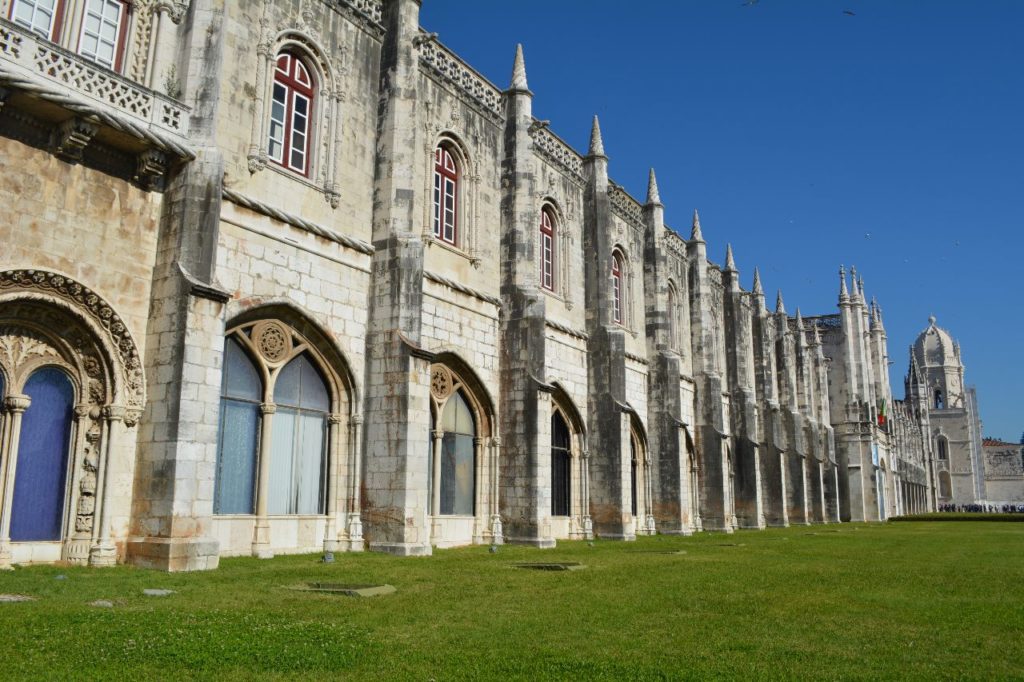
The interior features other Gothic elements such as vaulted ceilings with distinct stone ribbing. You can also see that this is a later Gothic Building that uses slender columns as a way to create an airy open interior space. The monastery served as the main burial site for members of the Portuguese Royal Family. Today along with Belém Tower, it’s listed as a UNESCO World Heritage Site. The monastery also contains a naval museum and an archeological museum, both of which focus on the history of Lisbon and Portugal.
2. Belém Tower
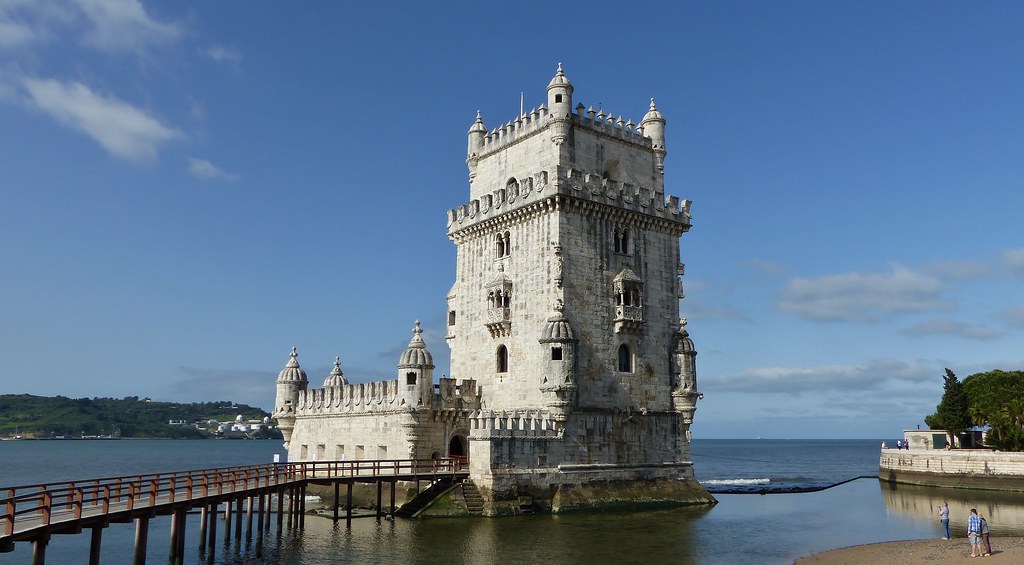
Another incredible example of Manueline Architecture in Lisbon is the Tower of Belém. The tower was built as a fortification to help protect Lisbon and the mouth of the Tagus River. It was strategically placed in a tidal area, so the tower becomes partially submerged at high tide. This strategy made attacks on the tower incredibly challenging, which was a strategy used in several of the world’s greatest Medieval Castles. Construction began on the tower in 1514, during the peak of Portugal’s expansion during the Age of Discovery. Over time as technologies advanced, the tower was regularly upgraded with the latest and greatest in cannon design. This allowed it to attack ships and helped prevent any opposing navies from blockading the port of Lisbon.

Gothic was the dominant architectural style in Europe during the early Middle Ages. Check out our article on the Top 25 Examples of Gothic Architecture to learn more!
3. São Jorge Castle

São Jorge Castle is one of the oldest works of architecture in all of Lisbon. It has been continuously modified since ancient times, with expansions being done by the Romans, the Moors, and the Kingdom of Portugal. The portions of the Medieval Castle were built with square towers constructed from light-colored limestone. After the adaptation of gunpowder, the Portuguese added several bastions and earthen walls to help defend the fortress from cannon fire. Today thousands of visitors come to the castle every year to climb the castle walls and get commanding views over the entire city.
4. Lisbon Cathedral
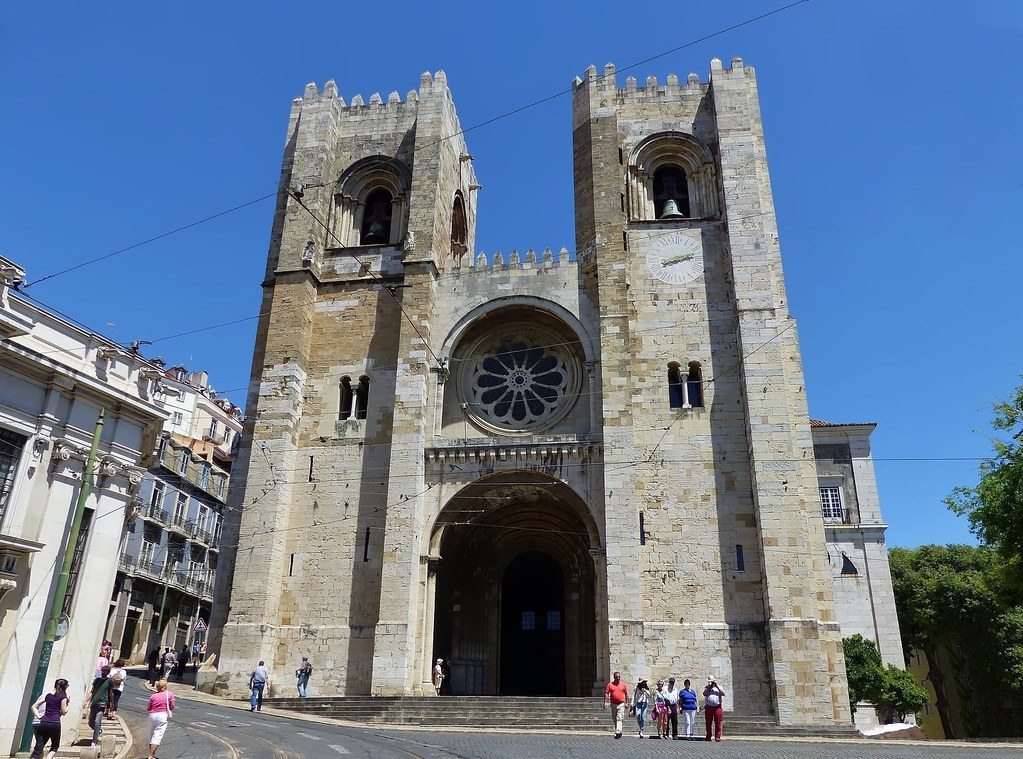
Lisbon Cathedral dates from the time shortly after the conquest of Lisbon in 1147. At that point, the city switched hands, and the Islamic Moors were pushed out by a combined force of Portuguese soldiers and Crusader Knights. The church was built in the Romanesque Style, which was the first unifying form of architecture in Europe after the fall of the Roman Empire. Lisbon Cathedral is built with round arches, thick walls, and small windows – which are all typical Romanesque elements. The church also doubled as a fortification, and you can see defensive features in the two towers such as battlements and arrowslits.
5. Carmo Convent

The Carmo Convent is one of the most iconic buildings in the skyline of Lisbon. It sits at a high point overlooking the Baixa Neighborhood and it was originally founded in 1389. The convent was one of the many casualties of the 1755 Lisbon Earthquake, and the entire roof of the main chapel collapsed. It’s a constant reminder of the power of the quake, which changed the history of Lisbon forever. Surprisingly, this destruction didn’t ruin the spirit of the Carmo Convent. Today it’s one of Lisbon’s most popular attractions, and visitors get the unique experience of a sort of open-air church that’s connected with the sky above.
6. Church of Our Lady of the Conception

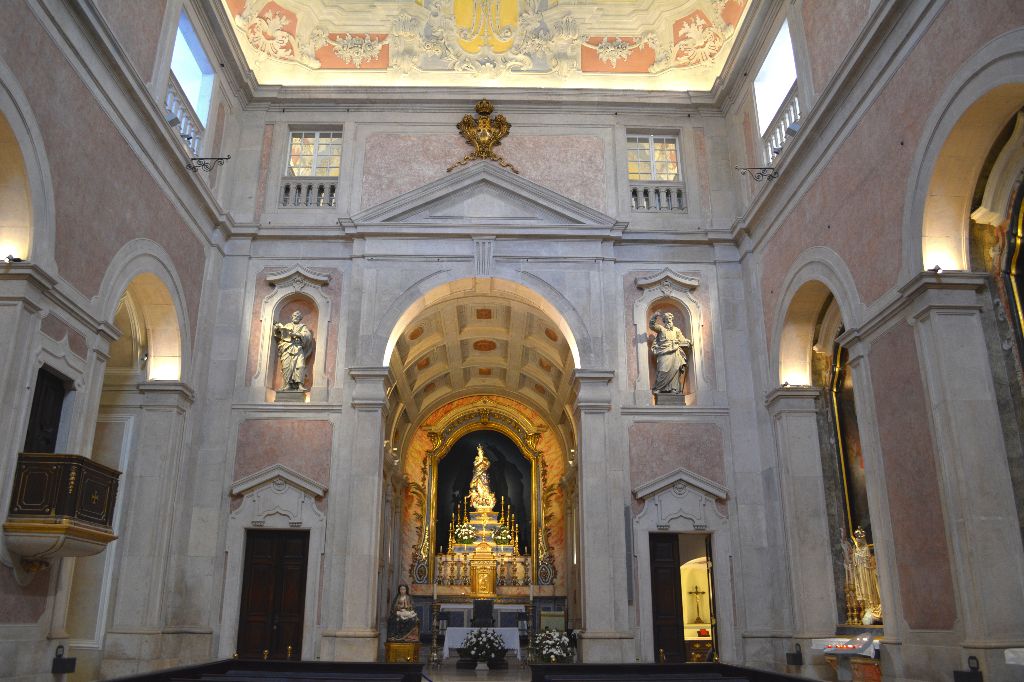
The Church of Our Lady of the Conception is another building within Lisbon that demonstrates the city’s complex history. The front facade is built in the Manueline style, and it miraculously survived the destruction of the earthquake. The interior of the building, however, was lost after the collapse of the roof and the subsequent fires that consumed this part of the city. The interior was completely redone in the Baroque style, which greatly contrasts the Manueline exterior. The pastel-pink color on the walls, the marble statues, and the elements of Classical Architecture within the interior are all some of the key features of Baroque Design.
7. Church of São Domingos

The Church of São Domingos was built in 1241 and was one of the largest churches in all of Lisbon back in the 13th century. It was updated and renovated a few times over the course of history and it presumably was a pristine work of architecture at one point in time. Unfortunately, most of the structure collapsed in the 1755 earthquake. Rather than refurbish the church back to its picturesque state from before, the building was only partially restored. The roof was redone and the glass was replaced to enclose the interior, but all of the tattered and damaged finishes were kept as-is. This decision has made the Church of São Domingos a very somber and thought-provoking monument within Lisbon’s city center.
Renaissance & Baroque Architecture in Lisbon
In the later stages of the Portuguese Empire, new forms of architecture were taking hold in Europe. The Renaissance Movement first spread out of Italy in the late 1400s, and it was followed by the Baroque movement in the 1600s. Dozens of buildings in these two styles were constructed within Lisbon. Although some of the most notable examples like the Ribeira Palace were destroyed in the Lisbon earthquake, a number of impressive buildings remained intact. Most of these sites can be found further out from the center. Although some of the buildings in the Great Rebuild of Lisbon were also in these two styles, those will be covered in the next section of this article.
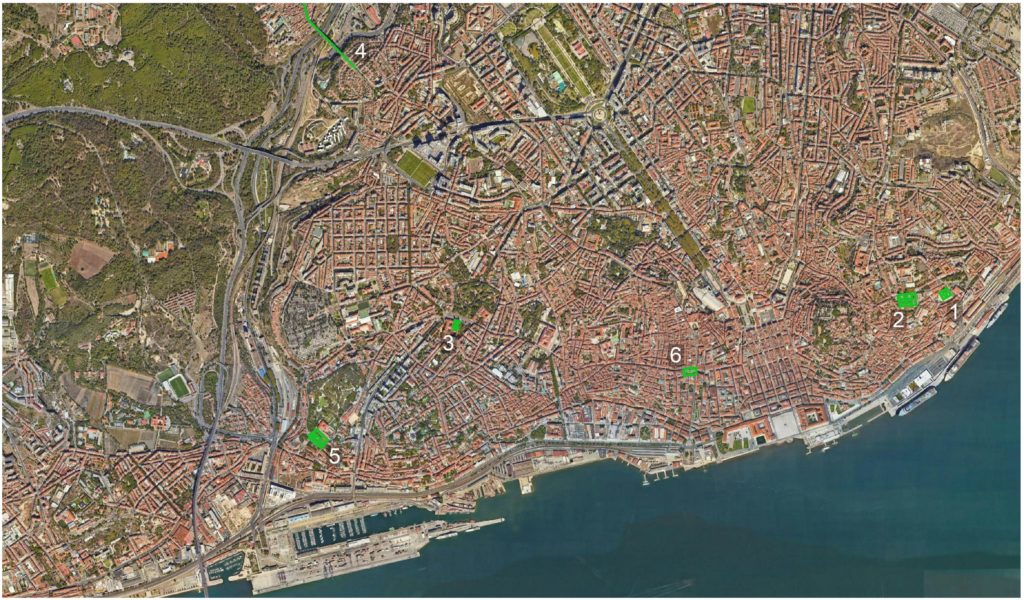
Map of Lisbon highlighting the most notable works of Renaissance and Baroque Architecture within the city.
1. National Pantheon
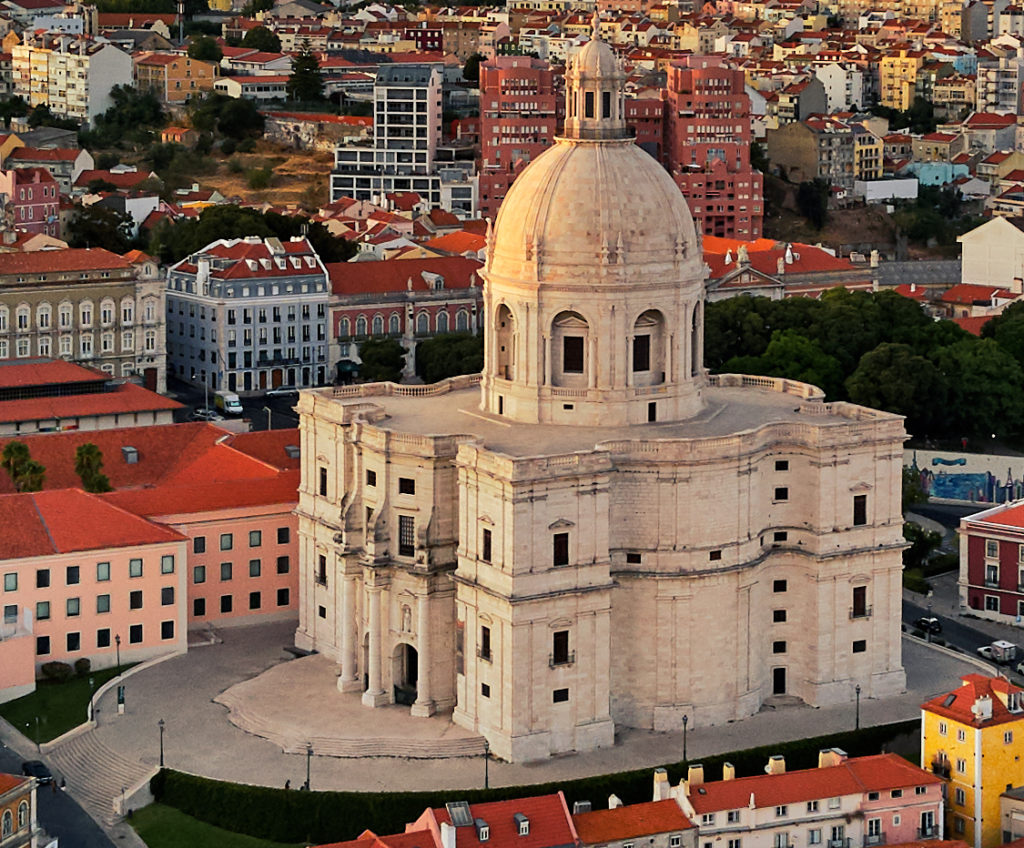
The National Pantheon of Lisbon, which is also known as the Church of Santa Engrácia, is a Baroque church located to the east of the Alfama neighborhood. The church is famous for its iconic dome, which can be seen from all over Lisbon. Construction originally began in 1681, at the height of the Baroque Age. However several factors lead to work ceasing on the building. It remained unfinished, and a lack of funding delayed its completion to the 20th century.
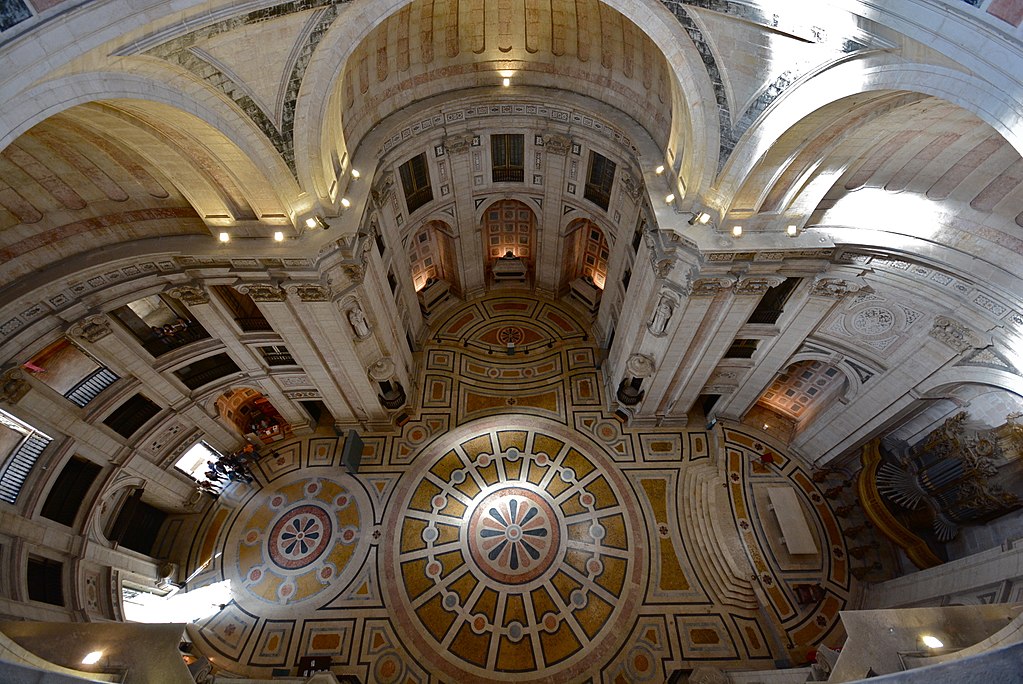
The National Pantheon is built in a symmetrical Greek Cross style plan, which differs from most of the other Latin Cross style churches in the city. Although it was originally built as a house of worship, it was converted into the National Pantheon of Portugal during the days of the First Portuguese Republic. It contains the tombs of some of the nation’s most important people. Within the building, you can find the graves of former presidents, writers, musicians, and even famous football players.
2. Monastery of São Vicente de Fora

The Monastery of São Vicente de Fora is a large complex of buildings located in Lisbon, not far from the National Pantheon. The current buildings on the site date to the 1580s, but the original monastery dates from the Romanesque period. The main church building was built in the Mannerist style, which was a form of architecture in the later stages of the Renaissance. The front facade shows all of the key elements of Renaissance design, including symmetry and proportion, as well as the use of classical elements such as the statues within the niches.
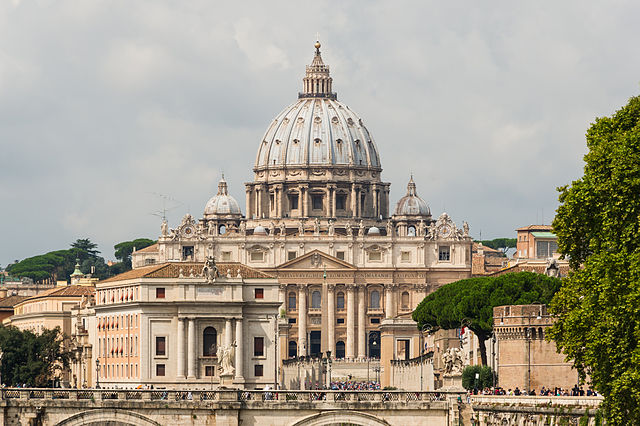
The Renaissance Style began in Italy and eventually spread to the rest of Europe. Check out our article on Renaissance Architecture to learn more!
3. Estrela Basilica
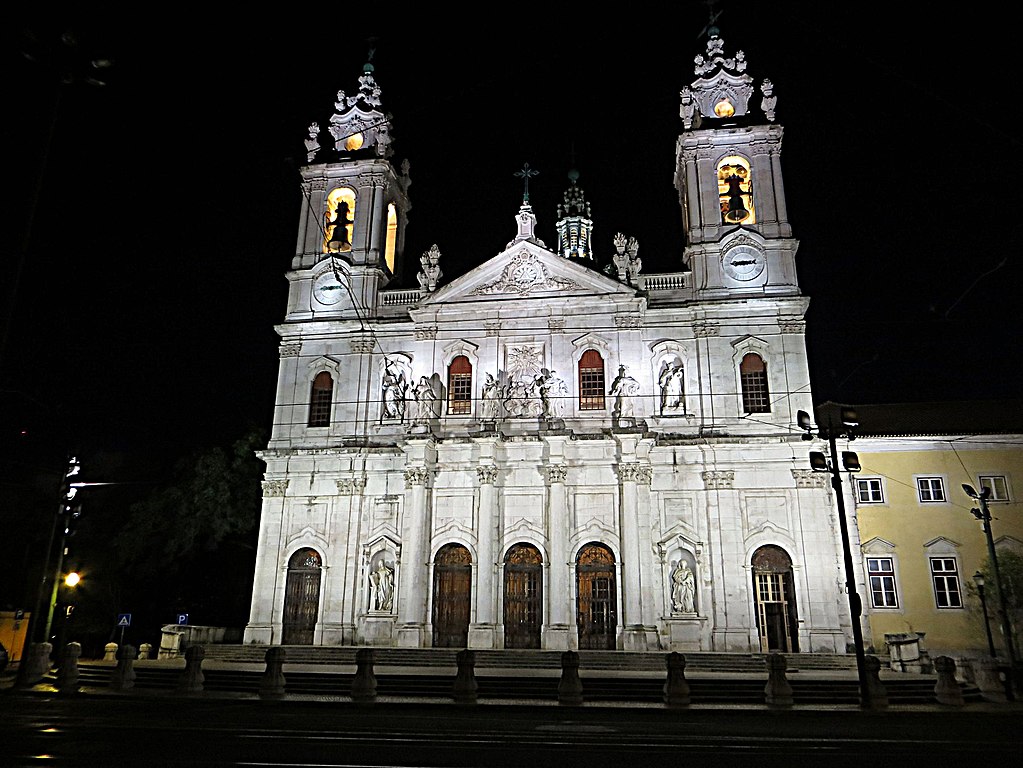
The Estrela Basilica was commissioned by Maria I of Portugal, and construction began on the church in 1779. At the time, Maria I was acting as the head of state within the Kingdom of Portugal, after her husband José I had passed away two years prior. The church was built entirely within the Baroque Age, and because of that, the entire building is in one cohesive Baroque style. You can clearly see the evolution of the Late Renaissance to the Baroque in the two facades of the Estrela Basilica and the Monastery of São Vicente de Fora. The later Baroque building is more intricate and detailed, and it contains new forms and geometries that weren’t around in the Renaissance.
4. Águas Livres Aqueduct

The Águas Livres Aqueduct is a rare piece of Baroque-Era infrastructure located within Lisbon. It was built to bring fresh water in from a source far away from the city center. Construction began on the project in 1731, and although it doesn’t bear any of the typical Baroque design elements, it’s still very impressive and imposing. The aqueduct was built with both round arches and pointed arches, which is part of what gives it a unique character. Moving water through different elevations by the use of aqueducts has been a key element in many cities since the great Aqueducts of the Ancient Romans.
5. Necessidades Palace

Necessidades Palace is a Baroque Palace located halfway in between the historic center of Lisbon and the Belém neighborhood. It was built in the Baroque style in the 18th century, and it served as a royal residence for several members of Portugal’s Braganza Dynasty. The pink pastel color and the elements of classical architecture are two distinct characteristics of Baroque design in the building. Today the Necessidades Palace is owned by the state, and the building currently houses the Portuguese Ministry of Foreign Affairs.
6. Praça de Luís de Camões

Luís de Camões, whom the square is named for, is regarded as the greatest writer in Portuguese History. He was a poet in the 1500s who wrote in the Portuguese Language. His works are as cherished today by the modern people of Portugal as they were back in his time. Located in a neighborhood that partially survived the great Lisbon earthquake, this square still contains some older buildings from before 1755. At the center of the square is a statue of Luis de Camões to commemorate his many accomplishments. Throughout the square, you can see some of the distinct two-tone cobblestone pavers that are prevalent throughout Lisbon.
Like Architecture of Cities? Sign up for our mailing list to get updates on our latest articles and other information related to Architectural History.
The Great Rebuild of Lisbon
On the morning of Saturday, November 1, 1755, a massive magnitude 8.4 earthquake struck Lisbon. That particular day happened to be of religious importance, so the city and its churches were packed with worshippers. The earth shook violently for several minutes, and in that time a large area of central Lisbon completely collapsed. The damaged buildings then became engulfed with great fires, which spread throughout the city. Finally, within hours of the quake, a massive tsunami ripped across the Tagus River delta and brought even more devastation. By the end, the city center, as well as tens of thousands of lives, were lost. Today it is referred to as The Great Lisbon Earthquake of 1755.

Maps Data: Imagery © 2021 CNES / Airbus, IGP/DGRF, Maxar Technologies, Map Data ©2021
Map showing the historic center of Lisbon. The dashed line represents the approximate area that was completely destroyed in the 1755 earthquake. The gridded buildings of the Baixa District are outlined in green.
Immediately after the disaster, the Portuguese Royal Family entrusted a high-ranking political official with the rebuild. He was the 1st Marquis of Pombal, Sebastião José de Carvalho e Melo – although most people simply refer to him as Pombal. Pombal used his shrewd and efficient military commanders to organize a complete rebuild of Lisbon. They drew up plans for a new gridded city plan, that had large straight boulevards connecting grand public squares. This reconstruction was done hastily, and most of the buildings are simplistic in design so they could be completed quickly. Once an assortment of winding medieval streets, the historic core of Lisbon is today an efficient, well-organized area, that is referred to as the Baixa District.

Map showing the historic center of Lisbon. The dashed line represents the massive axis that connects the Praça do Comércio to the Eduardo VII Park.
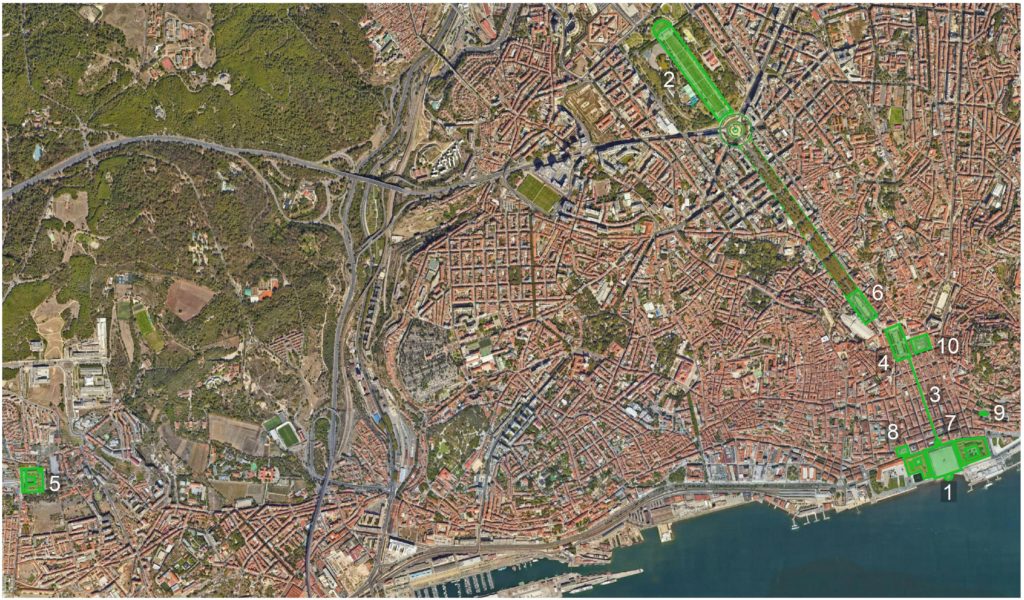
Map of Lisbon highlighting some of the greatest works of architecture from the Great Rebuild of Lisbon.
1. Praça do Comércio
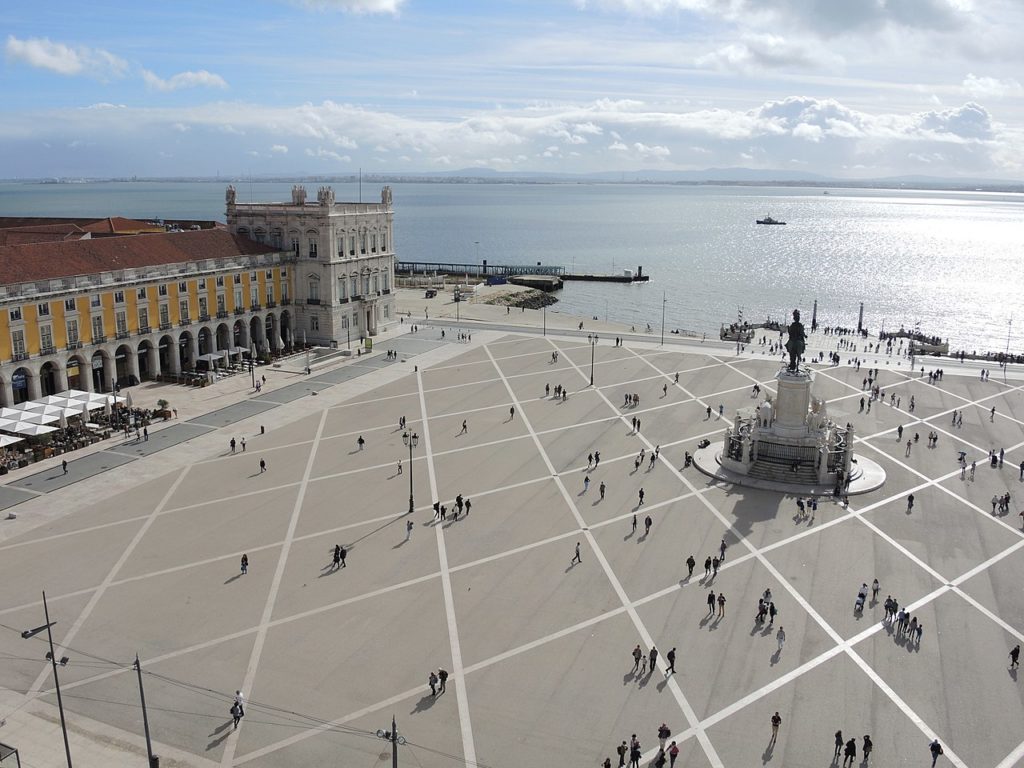
The crown jewel of Pombal’s great new rebuild is the Praça do Comércio. Translating in English to Commerce Square, it is a large square-shaped plaza located right along the waterfront of the Tagus River. At the center of the square, there is an equestrian statue of José I, who ruled Portugal at the time of the great 1755 earthquake. The famous Cais das Colunas is located where the square meets the sea. It is a pitched walkway that angles down below the surface of the water.

The square is surrounded on three sides by Baroque Era buildings. These are some of the more decorative structures built in the Pombaline Style, and they feature a large collonade along the ground level. Because the entire square was built at once, it looks incredibly cohesive with unifying colors and materials as well as perfectly aligned floor heights and windows. The Praça do Comércio loosely aligns with the former square that was located next to the Ribeira Palace, the royal residence of the Portuguese Monarcharchy before it was destroyed in the earthquake,
2. Eduardo VII Park

Located at the end of a massive axis that connects with the Praça do Comércio, is the Eduardo VII Park. The park is about 2 miles (3.2 km) from the Praça do Comércio and its also about 328 feet (100m) higher up in elevation. It’s one of the largest green spaces in all of Lisbon, and it’s surrounded by other historic buildings, gardens, and public squares. The Park itself is a well-manicured lawn with precisely planted hedges throughout. It’s long and straight and at the very top of the park is a monument dedicated to the 25th of April, the date of the Carnation Revolution in Portugal.
3. Rua Augusta
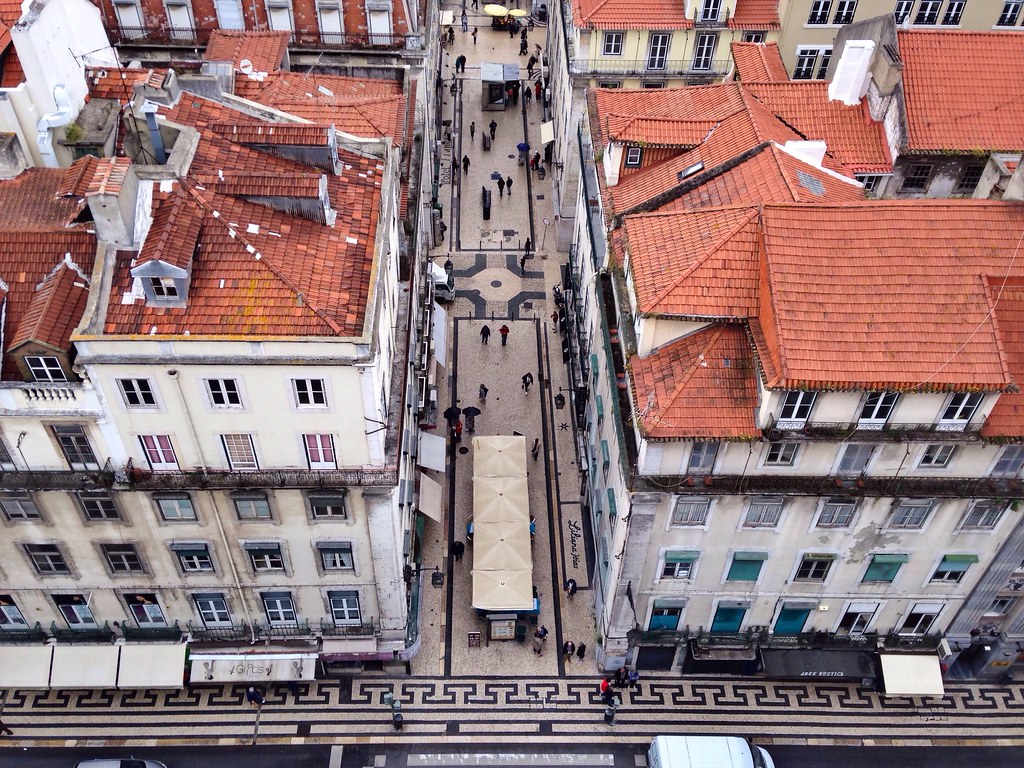
The Rua Augusta is the main pedestrian boulevard within the Baixa district. It sits at the center of the rebuilt area of Lisbon, and it connects the Praça do Comércio to Rossio Square. Lining the street you will find numerous shops, retailers, and many bars and restaurants. The street is often one of the busiest spots in the city and it is popular at all times of the day and night. It’s lined with a continual string of Pombaline-style buildings and it’s completely paved with the typical black and white stone pavers that are found throughout Lisbon.
4. Rossio Square

Rossio Square is one of several public squares designed as part of Lisbon’s rebuilt historic center. It features a very interesting pattern of the typical Lisbon cobblestones, with undulating curvatures of alternating color. Rossio Square also features some of Lisbon’s most impressive monuments. There are two Baroque fountains at either end, both featuring Baroque-era sculptures of mermaids and cherubs. Within the center of Rossio Square is a large monument dedicated to King Pedro I, who ruled over Portugal briefly in 1826. The monument consists of a column topped with a statue of Pedro I and it is reminiscent of the Triumphal Columns of the Ancient Romans.
5. Palace of Ajuda
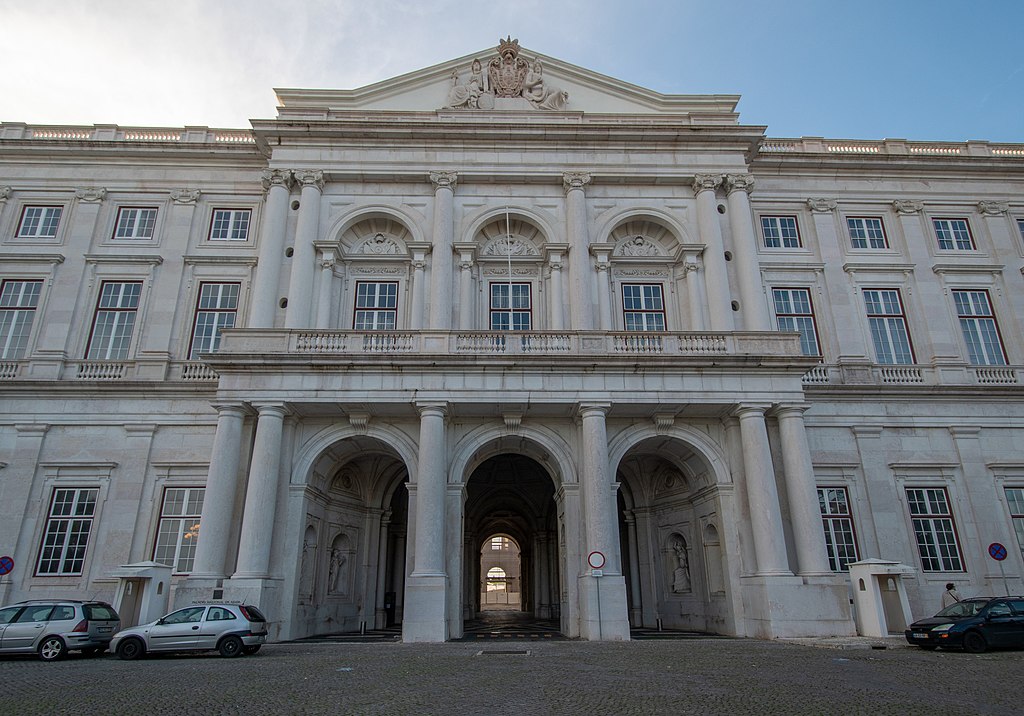
The Royal Braganza Family ruled over Portugal for centuries, beginning in the late Middle Ages. For a long time, they resided in a Renaissance & Baroque Style building known as the Ribeira Palace. In its day, it was one of the largest and most significant works of architecture in all of Lisbon, rivaling some of the other great palaces of Europe. But unfortunately, the Ribeira Palace was mostly destroyed in the earthquake and what remained of the building was quickly demolished to make way for the Praça do Comércio. The Ajuda Palace was constructed as a new royal residence for the House of Braganza. Construction was delayed, however, and the foundations weren’t begun until 1796. Because it was designed later on, the Palace of Ajuda is in a Neoclassical Style, Rather than Baroque like other buildings in the Baixa. The Palace was also never really completed, and a large wing on the western end of the building still remains unfinished.
6. Restauradores Square
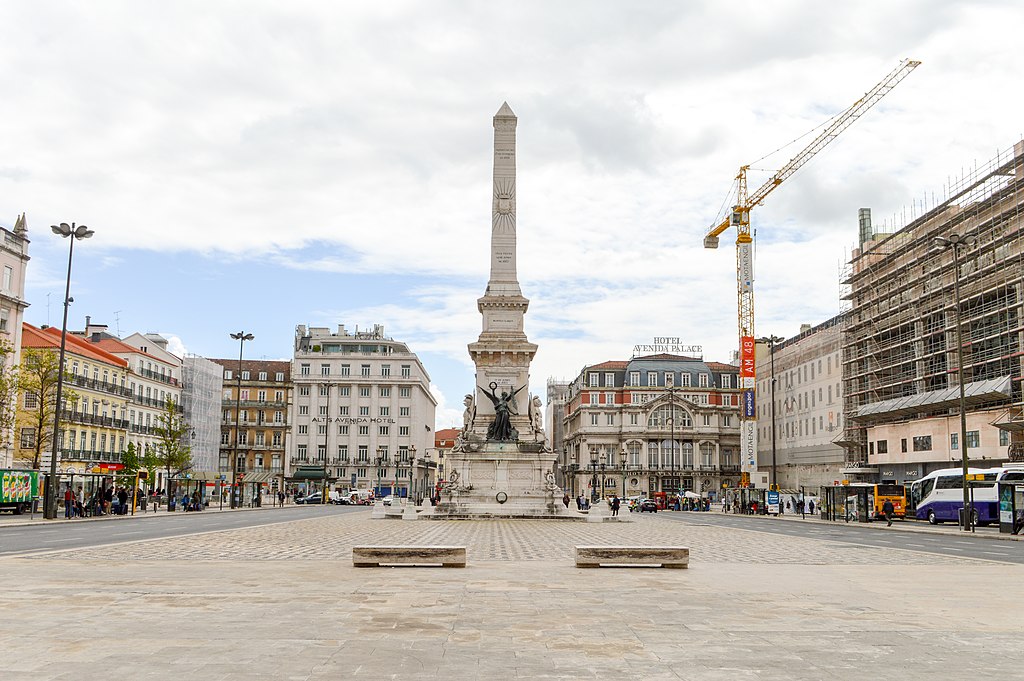
Restauradores Square or Praça do Restauradores in Portuguese, is another one of the large squares located within the rebuilt area of Lisbon. This square contains more of the same paving found throughout the city, as well as a massive stone obelisk. The obelisk commemorates the Portuguese Restoration War, a 17th-century conflict between Spain and Portugal. Restauradores Square is also home to several impressive works of architecture from other centuries. There are several Pombaline-era structures, as well as the Rossio Railway Station, which was built in the early 19th century in a Neo-Manueline Gothic style.
7. Augusta Arch
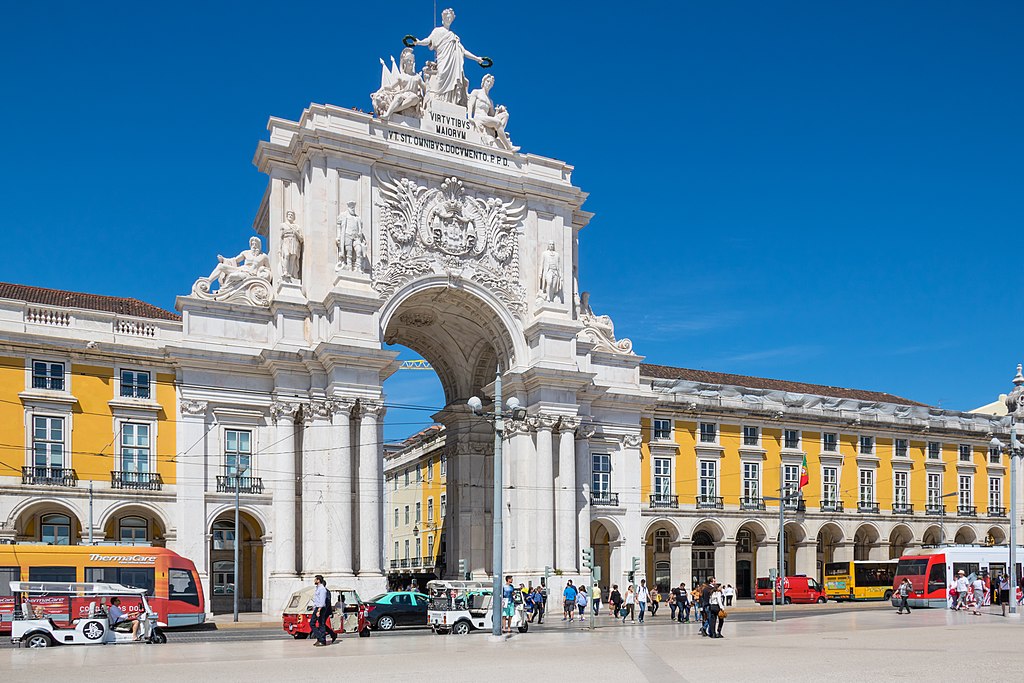
The Agusta Arch is located where the Praça do Comércio connects with Rua Augusta. It stands tall looming over the surrounding area, and it’s intentionally built taller than the adjacent buildings in the Baixa district. Modern-day visitors are able to climb to the top of the arch to get a commanding view of the city as well as the mouth of the Tagus River. The arch itself is a form of Triumphal Arch that resembles the great Triumphal Arches of the Romans who once controlled Lisbon. It’s also richly decorated with various stone elements such as columns, statues of important Portuguese figures, and the coat of arms of the House of Braganza.
8. Praça do Municipio

The Praça do Municipio, or Municipal Square, is another one of the five major squares from the great rebuild of Lisbon. These squares were all part of the new Pombaline plan to rebuild the city’s Historic Center. The square features more of the black and white stone paving that you see throughout the city, and this time, the stones are orientated in a distinct geometric pattern made up of hundreds of triangles. It’s named Municipal Square to honor Lisbon City Hall, which is located on the eastern side of the plaza. Within the center of the Praça do Municipio is a monument known as the Pillory of Lisbon. The Pillory is a commemorative column, and it features a distinct spiralized design that was common in Baroque Architecture. The current column dates to 1783, although a much older monument stood in its place until the earthquake of 1755.
9. Church of Saint Anthony of Lisbon
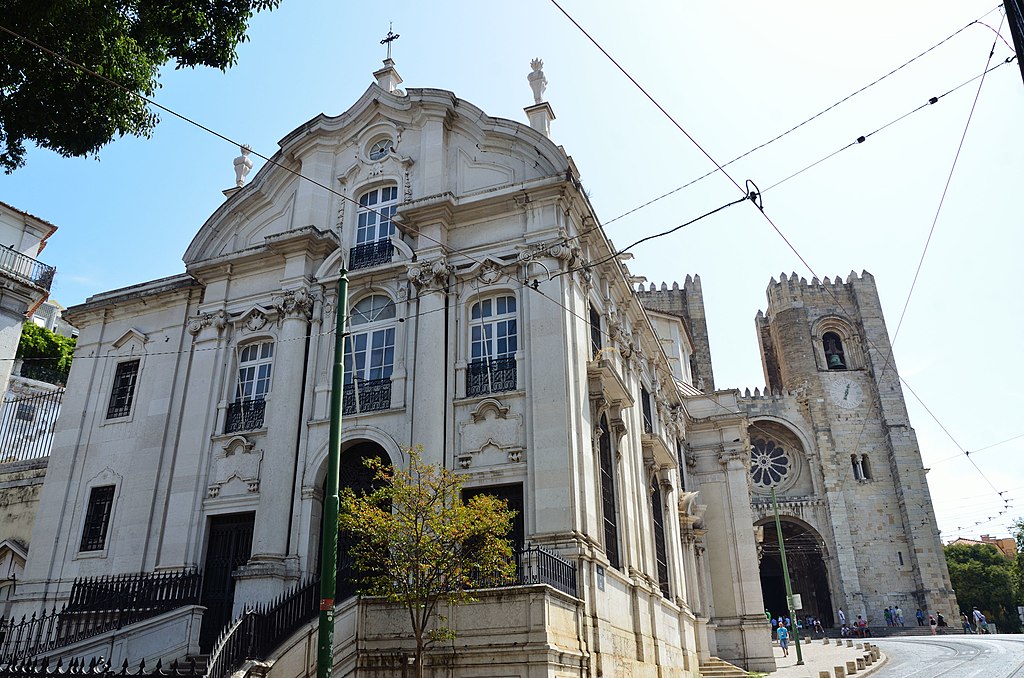
In addition to all of the grand squares and boulevards that were constructed in the Great Rebuild of Lisbon, a great deal of Religious Architecture was also built. The Church of Saint Anthony of Lisbon is a great example of this. It was built in the 1760s, shortly after the 1755 quake. It replaced an older church that had only recently been completed in 1730. The church is built in the Baroque Style, one of several impressive works of Baroque Architecture within Lisbon. The location of the church is also very significant, and a Christian saint known as Saint Anthony of Lisbon is said to have been born here in 1195.
10. Praça da Figueira

The Praça da Figueira is the final public square on this list that dates from the redesigned plan of Lisbon. Unlike a few of the other squares from the Great Rebuild, a public plaza did not exist at this location prior to the great earthquake. The new square was added by the Marquis of Pombal to open up the city and help prevent overcrowding. Although it’s not filled with impressive buildings and monuments like other squares in Lisbon, it’s still a great space that’s a popular hangout spot for both locals and tourists. At the center of the square is a large equestrian statue commemorating King John I, who ruled Portugal starting in 1357.
19th Century Architecture in Lisbon
Portugal went through several drastic changes during the 1800s. First, Napoleon invaded in 1807 during the Peninsular War. At this point, the Portuguese Royal Family fled the country and headed for Brazil, one of Portugal’s colonies. Shortly after the turmoil of the Napoleonic Wars, Brazil declared independence on September 7th, 1822. This led to a huge loss of revenue for Portugal, as Brazil was by far the most lucrative colony in the entire Portuguese Empire. Despite all of this, Lisbon managed to still grow significantly in the 19th century when it became heavily industrialized. Many incredible works of Revival Architecture like Neoclassical, Neo-Gothic, and Neo-Baroque buildings were constructed at this time.. Lisbon also saw a movement to restore the architecture of the Portuguese Golden Age. The city commissioned the incredible Rossio Railway Station, which is a reinterpretation of the famous Manueline Style of architecture from Lisbon’s peak during the Age of Discovery.

Map of Lisbon highlighting several important works of 19th-century architecture within the city.
1. Lisbon City Hall

Lisbon City Hall is a Neoclassical Style building located within Lisbon’s Praça do Município. The current building replaced an older one that burned down in the mid-19th century. The rebuild began in the year 1865. The facade greatly resembles the front of a Roman or Greek Temple, from ancient Classical Architecture. The Corinthian columns and the large triangular pediment above the front entrance are all key features borrowed from ancient temples. Lisbon City Hall is the home of the local government of the city, and it has been a vital municipal building since the late 1700s.
2. São Bento Palace

São Bento Palace is a massive Neoclassical building located to the West of Lisbon’s Historic Center. The building was originally a Benedictine Monastery back in the late 16th century. In the early 1800s, the Parliament of Portugal moved into the building, and over time they made great changes to the overall structure. After a fire in 1895, the Neoclassical temple-front facade was added to the building. Construction on this portion began right after the fire but wasn’t completed until well into the 20th century. Today the building is often referred to as the Assembly of the Republic because it still houses Portugal’s Parliament.

Interested in Neoclassical Architecture? Check out our article on the Architecture of Stockholm to see more great examples of Neoclassical Buildings.
3. Rossio Railway Station
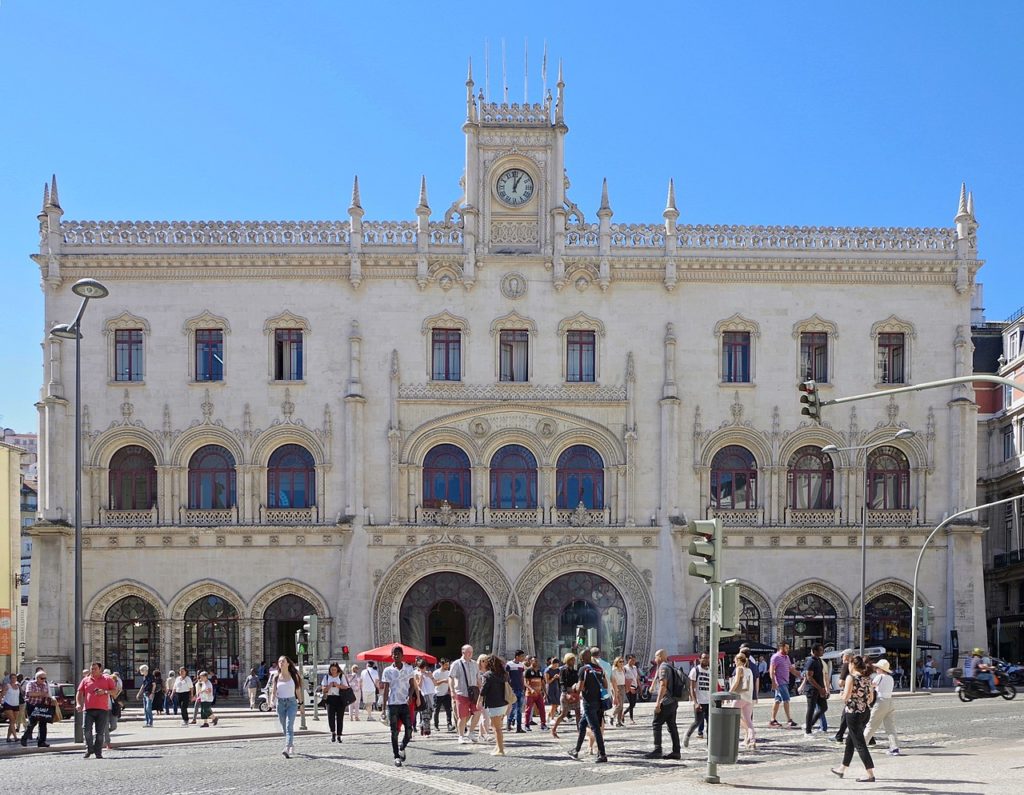
Rossio Railway station is one of the largest transportation hubs in the entire city of Lisbon. The main station building is located right in between Rossio Square and Restauradores Square. Behind the smaller stone building in the image above, there is a massive steel building that houses several railway lines that connect Lisbon to nearby cities such as Sintra, Coimbra, and Porto. The facade of the station was built using Neo-Manueline Architecture, with pointed arches, pinnacles, and other Gothic Revival details throughout. The design is meant to resemble the buildings from Lisbon’s Golden Age when Manueline Architecture was being constructed by Portuguese Kings like Manuel I.
4. Queen Maria II National Theater
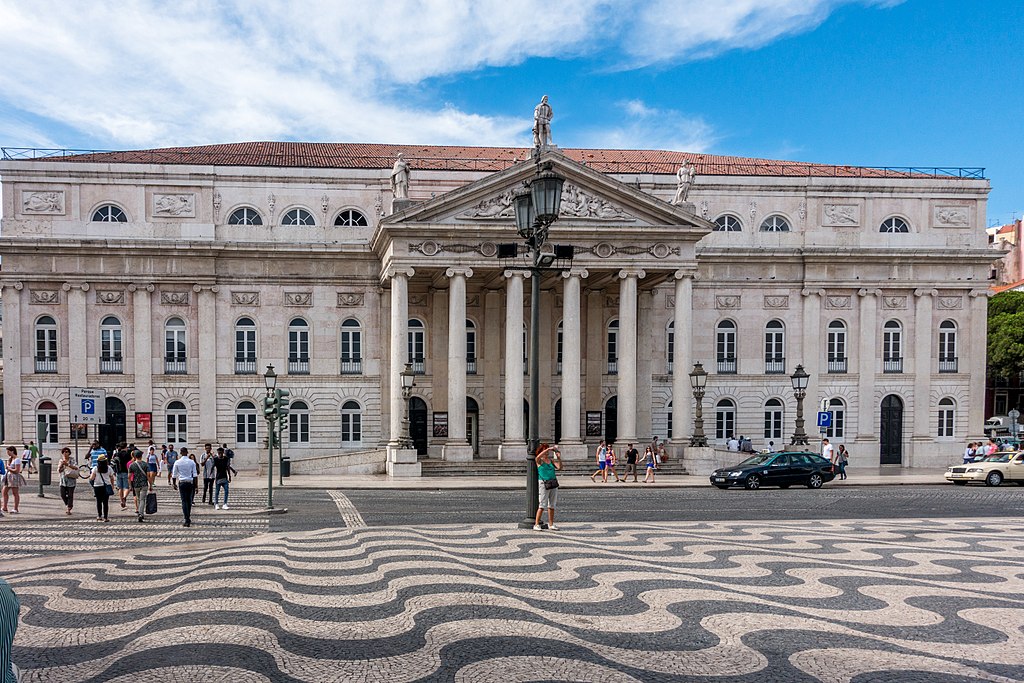
The National Theater of Queen Maria II is a large Neoclassical building overlooking Rossio Square in the Baixa District of Lisbon. The front facade is a classic example of this style of architecture. It greatly resembles the facades of many Ancient Roman buildings, and also the facades of hundreds of government buildings found throughout the world. Neoclassical was one of the first building forms to really take off throughout the entire globe. You can find examples of this style in European cities like Lisbon, London, and St. Petersburg; but also in the Americas, in cities like Washington DC and Mexico City. The Queen Maria II National Theater was completed in 1842, and it has been hosting constant performances ever since.
5. Santa Justa Lift

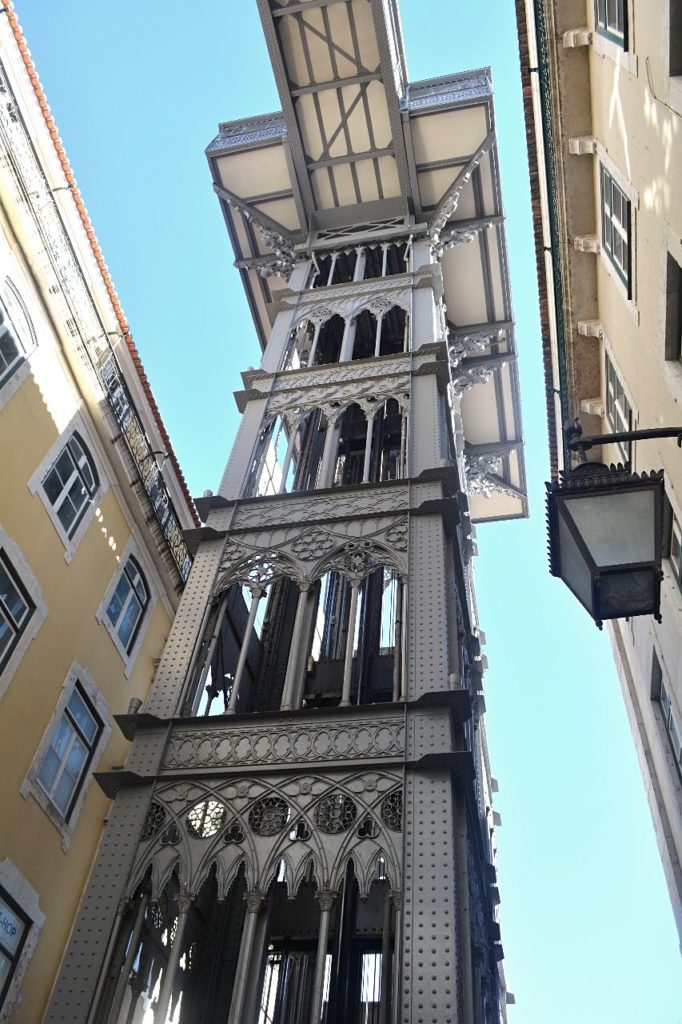
The Santa Justa Lift is a very unique structure located on the outer edges of the Baixa neighborhood in Lisbon. Lisbon is a city filled with steep hills and deep valleys, mostly because of its proximity to the Tagus River. The Santa Justa Lift was constructed in the early days of the elevator in the year 1899. It brings people up a hill from the lower streets of the Baxia up to the Carmo Convent and the surrounding square called the Largo do Carmo. While the lift technically isn’t a building, it’s still an impressive piece of architecture. It features ornate detailing in the metal surrounding the elevator shaft, and it has a distinctly industrial look that you find in many buildings from the late 19th century.
6. Mercado da Ribeira


(right) Photo by Nan Palmero from Wikimedia Commons
The Mercado da Ribeira is another great example of late 19th-century architecture in Lisbon. The building was completed in the year 1882 when it opened as a traditional Portuguese market. Local vendors would sell produce, baked goods, cheeses, meats, and seafood. Eventually, in the 20th century, the market was in decline as more modern grocery stores were built throughout the city. Since 2014, the Mercado da Ribeira has housed the “Time Out” Market of Lisbon. “Time Out” market is a unique food hall concept that combines regional cuisines in a counter-serve restaurant style. There are several “Time Out” Branded markets in other cities such as Boston, New York, and Montreal. And there are several new “Time Out” Markets that have yet to open in cities like London and Prague.
7. National Museum of Ancient Art
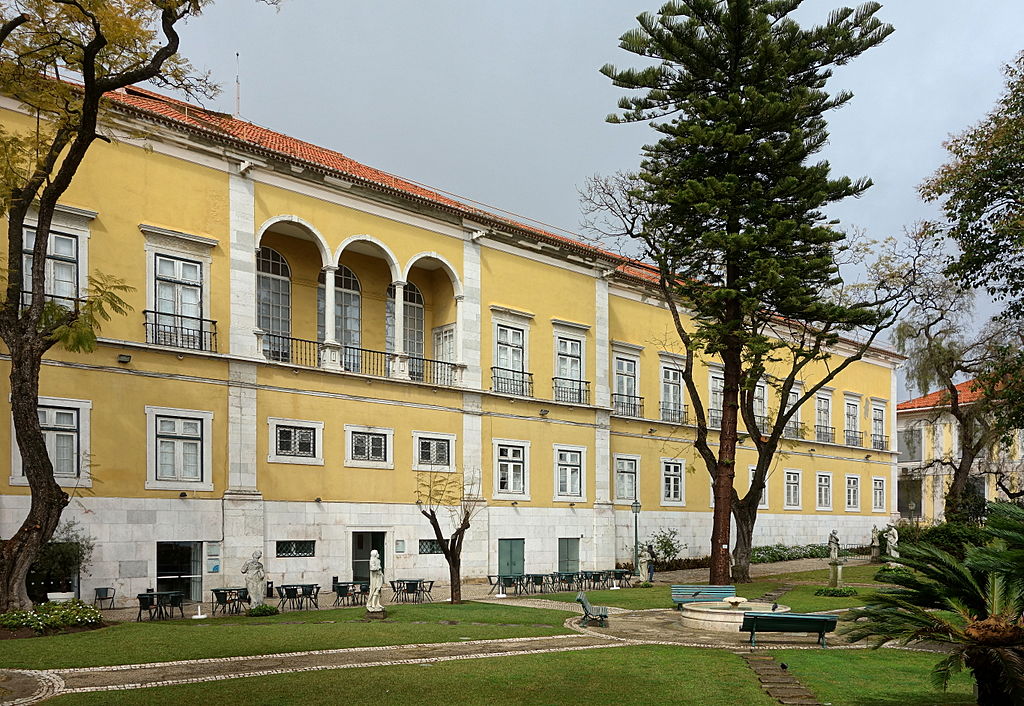
The National Museum of Ancient Art is a museum in Lisbon containing works of art from many different eras and regions. Most of the pieces were once owned by the House of Braganza, and they include Renaissance Paintings, Ancient Sculptures, and imported furniture and ceramics from China and India. The building itself was built as a residence for the 1st Marquis of Pombal, who was instrumental in the great rebuild of Lisbon. It sits atop a steep slope, with views overlooking the Tagus River which is just a few hundred feet away. The museum was installed within the building in 1884, and today it’s one of the most visited museums in all of Lisbon.
8. Carlos Lopes Pavillion
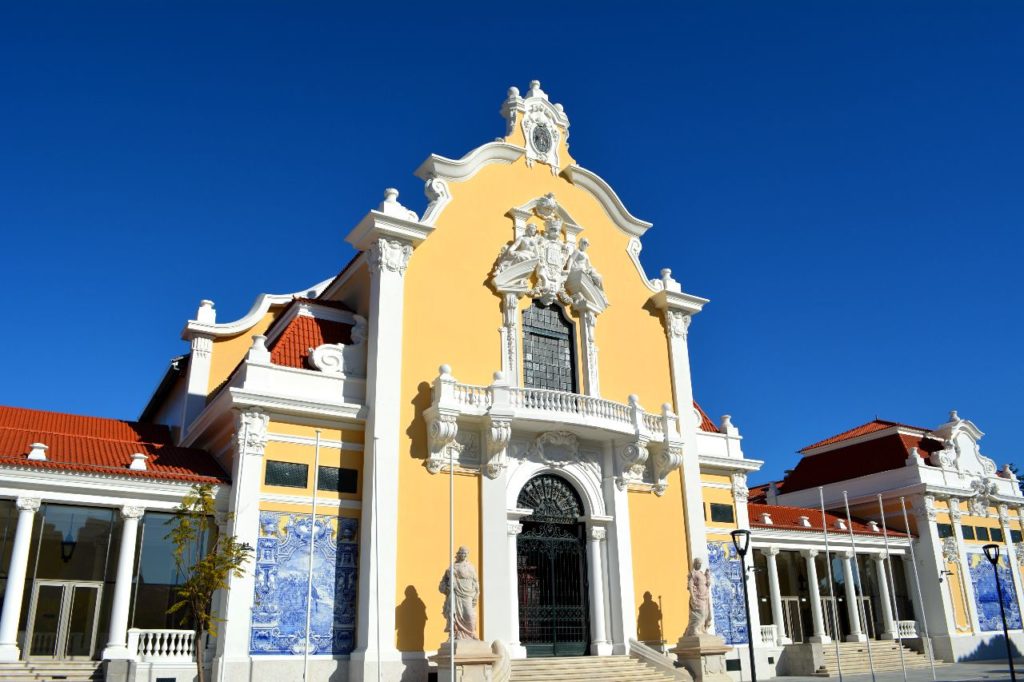
The Carlos Lopes Pavillion is located just to the West of the linear expanse of the Parque Eduardo VII. It serves as an event space within Lisbon, and it hosts an assortment of art, music, and cultural events. The building is famous for its use of Azulejo Tiles, which can be found throughout Portuguese architecture. These porcelain tiles are almost always blue and white, and they often contain geometric patterns of varying shapes. In some cases, Azulejo Tiles are used to create large-scale murals. You can see these works of art throughout the exterior of the Charles Lopes Pavilion, along with other design elements inspired by older Baroque-era buildings.
Modern Architecture in Lisbon
The 20th and 21st centuries brought drastic change to both Portugal and Lisbon. In 1910, Portugal saw a revolt that lead to the dissolution of the Portuguese Monarchy and the formation of the First Portuguese Republic. However this era in Portuguese history would be short-lived, and another regime known as the Estado Novo would take over in 1933. The Estado Novo would be primarily controlled by one man, António de Oliveira Salazar who ruled as Prime Minster from 1932 t0 1968. Some argue that Salazar acted more as an autocratic dictator than a Prime Minister, and his foreign policy as a ruler was often questioned by groups such as the United Nations. The Estado Novo attempted to maintain control over Portugal’s colonial-era territories in Mozambique and Angola, which were both revolting in the armed conflict known as the Portuguese Colonial War.
The war saw great bloodshed for both the Portuguese Armed Forces and the local populations in Africa. Eventually, the people of Portugal grew tired of the war, and they peacefully rose up on the 25th of April 1974. This was an act now known as the Carnation Revolution. Since then the modern Portuguese State has focused on internal improvements to generate more wealth and prosperity for the Portuguese people. Portugal was hit hard by the Global Economic Crisis of 2008-2009, but today it lives on as a thriving nation within the European Union. Lisbon continues to serve as Portugal’s capital, and the city has embraced the modern age by building several great examples of Contemporary Architecture throughout its historic neighborhoods.

Map of Lisbon highlighting various works of Modern Architecture within the city.
1. MAAT
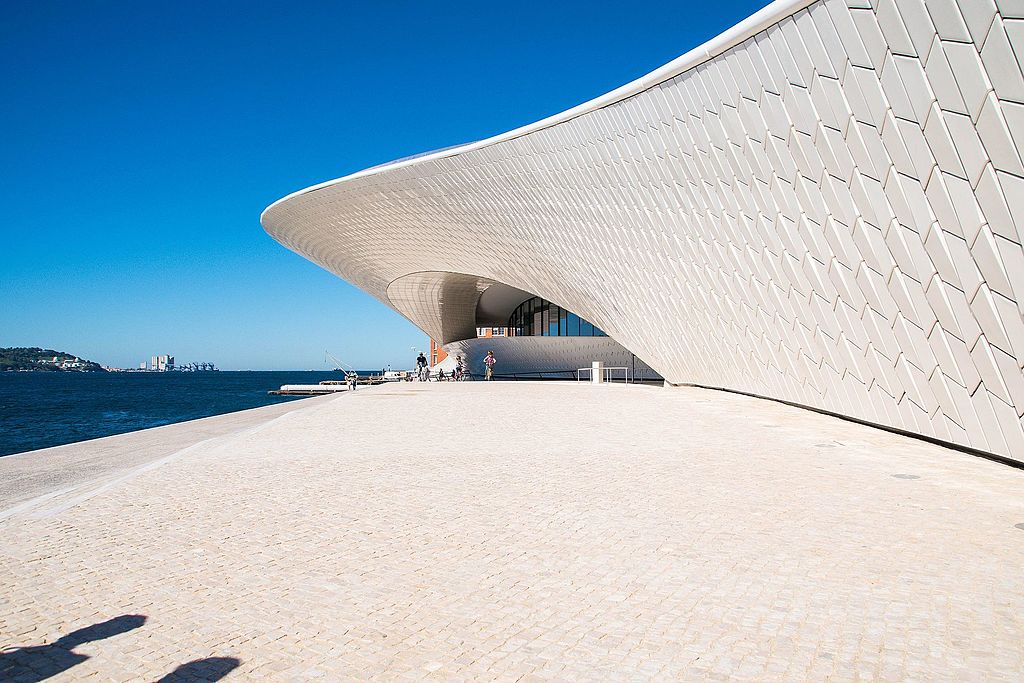
One of the most striking examples of contemporary architecture in Lisbon is the MAAT. MAAT is an acronym for the Museum of Art, Architecture, and Technology. Within the building, you can find several exhibits related to these three things. The museum is one of several 21st-century projects designed to improve the waterfront region of Lisbon. This area became a mix of warehouses, power stations, and factories during the height of the Industrial Revolution. Although the inside of the building contains many interesting exhibits, many visitors enjoy the MAAT building without going inside. The entire structure is designed with gentle curves, reminiscent of the waves and currents of the adjacent Tagus River. The roof of the museum is easily accessible by a series of ramps, and atop visitors can take in a great view of the river below.
2. Monument of the Discoveries
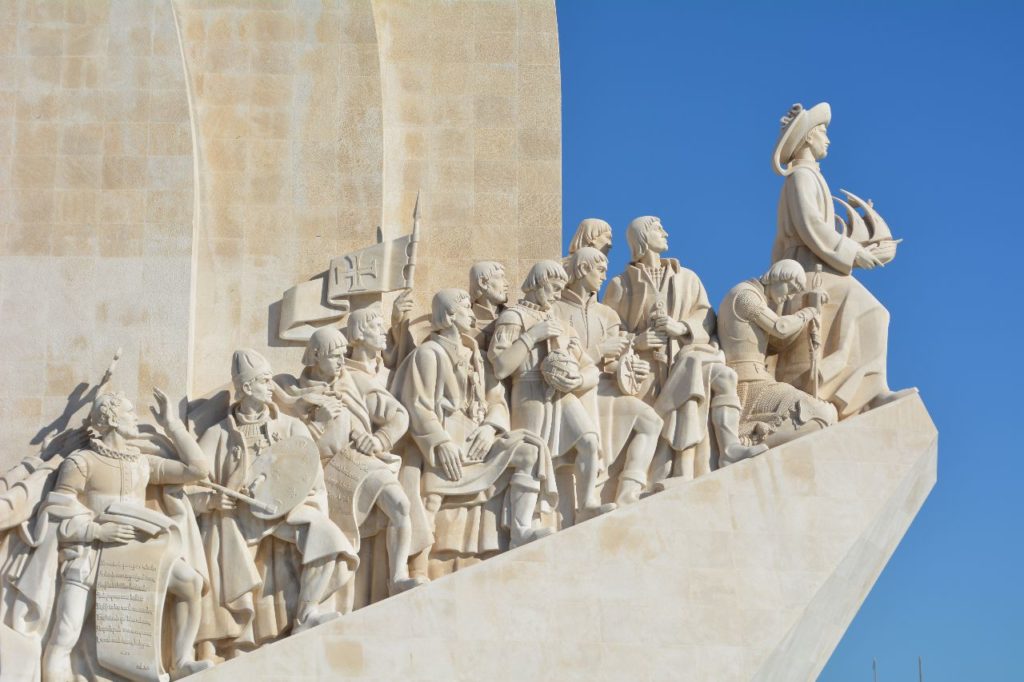
Known in Portuguese as the Padrão dos Descobrimentos, the Monument of the Discoveries is a giant sculpture dedicated to the explorers of the Portuguese Age of Discovery. It was completed in 1960 in a position overlooking the Tagus River. The form of the sculpture resembles a sailing ship, and it is decorated with larger-than-life figures of some of the greatest explorers in Portuguese history. These include Vasco de Gama, Henry the Navigator, and King Afonso V. The Monument of the Discoveries was built in the Neighborhood of Belém, where many of these explorers first set sail for faraway lands. It’s just a short walk away from some of Lisbon’s most impressive works of Gothic Architecture, such as Belém Tower and Jerónimos Monastery.
3. 25 de Abril Bridge
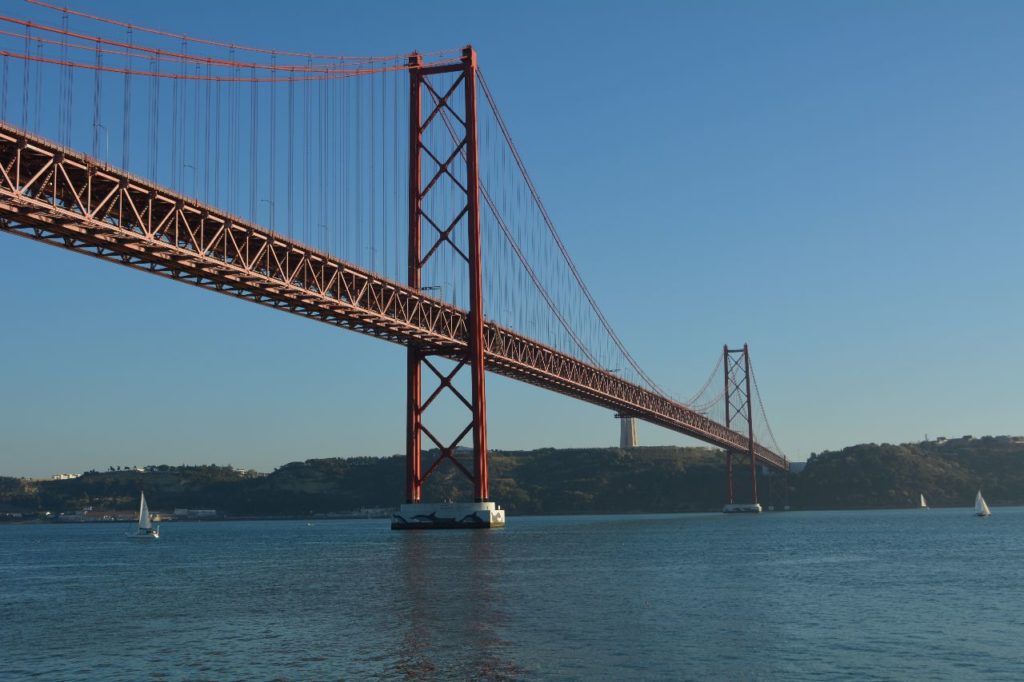
Named for the 25th of April, the date of the Carnation Revolution in 1974, the 25 de Abril Bridge is one of only two crossing points over the Tagus River around the city of Lisbon. It connects Lisbon with the town of Almada, which is located on the south bank of the Tagus. It was inaugurated back in 1966, and since its completion, it has been continuously compared to the Golden Gate Bridge in San Francisco California. It has a similar color, and it is also another example of a two-pier suspension bridge. Every day thousands of people cross over the bridge and it is one of the most recognizable landmarks in the entire region around Lisbon.
4. Lisbon Oriente Station

Lisbon Oriente Station, also known as the Gare do Oriente, is a modern train station located on the northern side of the city. It’s one of the largest transportation hubs in Portugal, and it contains several train lines as well as a large bus terminal. The station is located just over 5.5 miles (9 km) from the historic center of the city, in a much more modernized region of Lisbon. Lisbon Oriente Station opened in 1998, in time for the city to host the Expo ’98 fair. It was designed by the renowned architect Santiago Calatrava, who created an extremely contemporary glass canopy made up of tree-like structural elements.
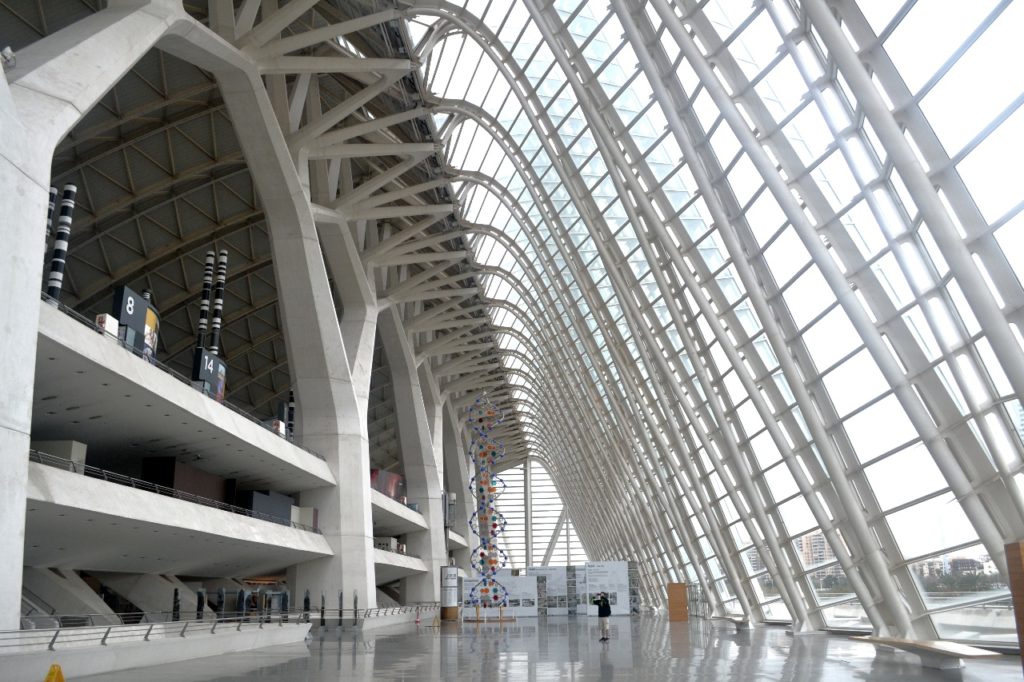
Interested in the architecture of Santiago Calatrava? Check out our article on the Architecture of Valencia to see more of his work at Valencia’s City of Arts and Sciences.
5. Vasco da Gama Bridge
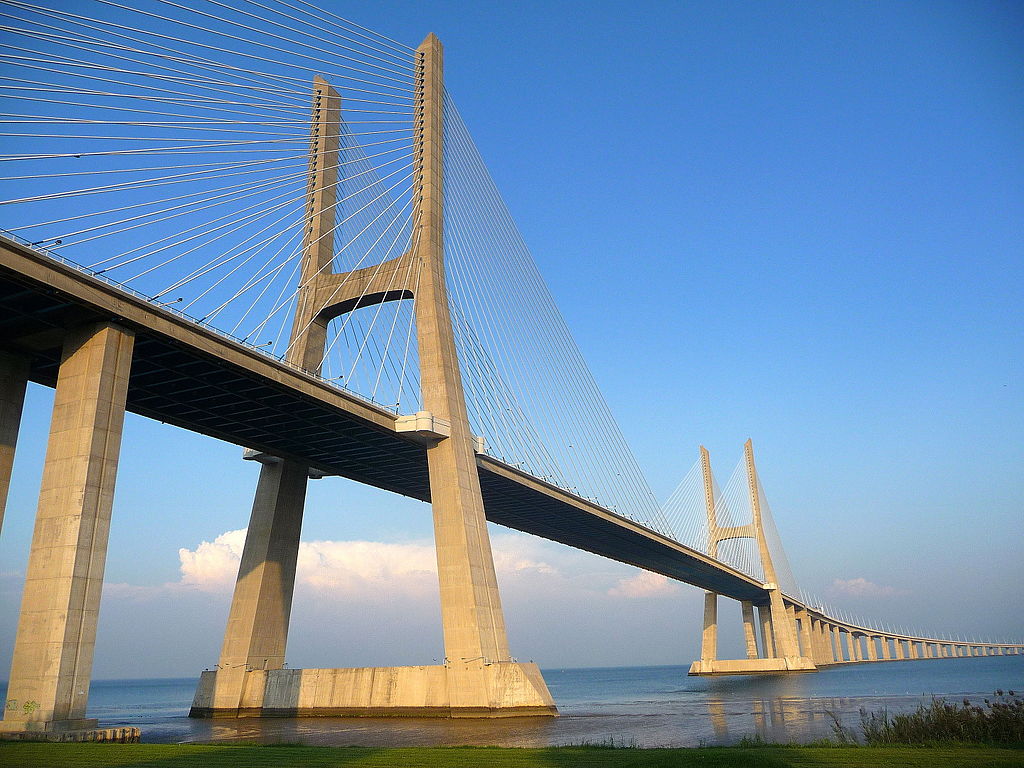
Vasco da Gama Bridge is one of two bridges crossing the Tagus River near Lisbon, the other being the 25 de Abril Bridge. The Vasco da Gama is the newer of the two bridges, and it was opened to traffic in 1998, after being under construction for 3 years. The ambitious project was a huge engineering achievement. Many regarded the project as necessary to improve Lisbon’s infrastructure and reduce the traffic levels on the 25 de Abril Bridge. The Vasco da Gama is currently the longest bridge in the entire European Union, and it carries travelers 7.6 miles (12.3 km) across the wide mouth of the Tagus River.
6. Belém Cultural Center
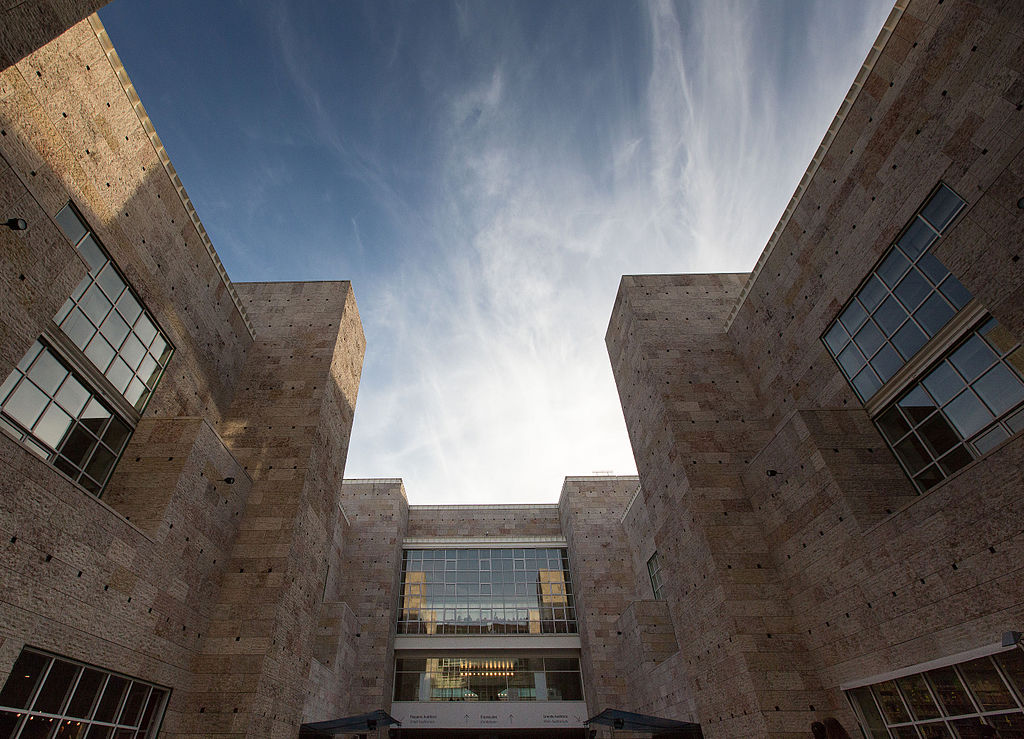
The Belém Cultural Center is one of several modern buildings located within the Belém neighborhood of Lisbon. It first opened its doors in 1992, and it hosts a wide variety of events including conferences, exhibitions, and performing arts festivals. Although it’s a modern structure that uses materials like glass, steel, and aluminum, it was also designed with more traditional materials like stone. Most of the exterior is veneered with stone as a way to connect the building with some of the more historic works of architecture within the Belém neighborhood.
7. Rectory of NOVA Lisbon University
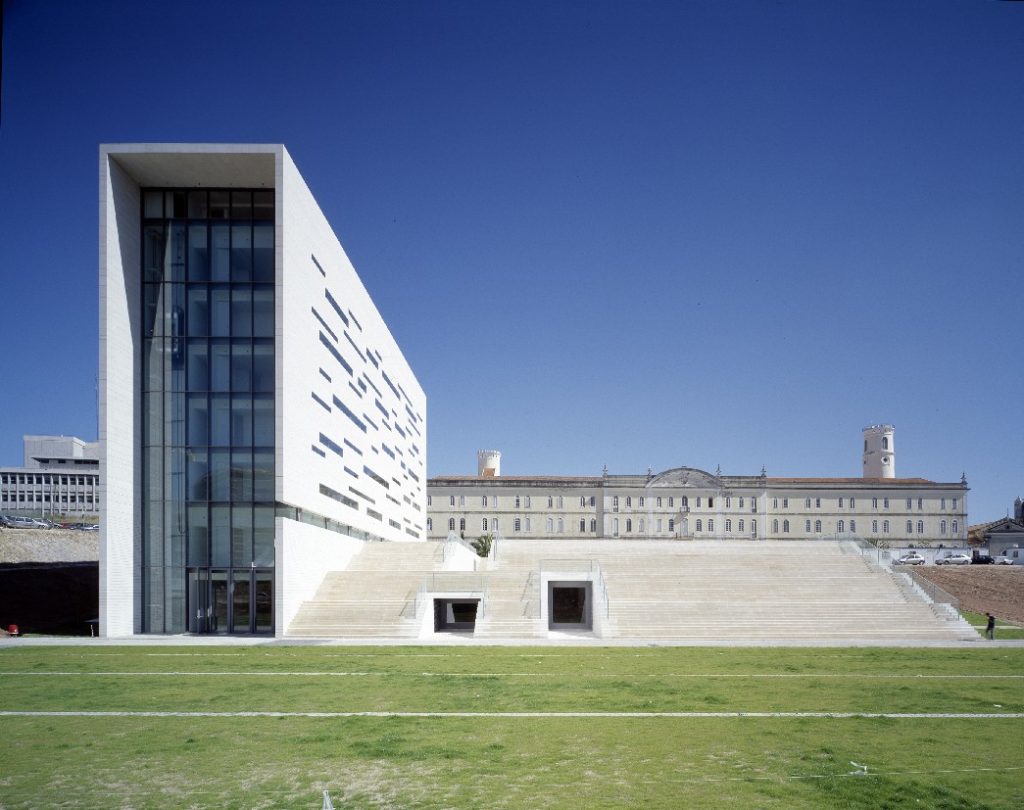
The NOVA University of Lisbon, often referred to as simply NOVA, is an institute of higher education located just north of the Parque Eduardo VII. Portugal has a long history of higher learning, and the nation’s first university was established in Coimbra all the way back in 1289. The NOVA was established in 1973, making it newer than most of the other major universities in Portugal, but it still ranks as one of the nation’s most prestigious schools. Although the NOVA University of Lisbon is housed within an assortment of buildings from many different ages, the Rectory of the university is a striking work of Contemporary Architecture. The building houses the offices of the Rector, who is the senior official within the school,
8. Pink Street Lisbon
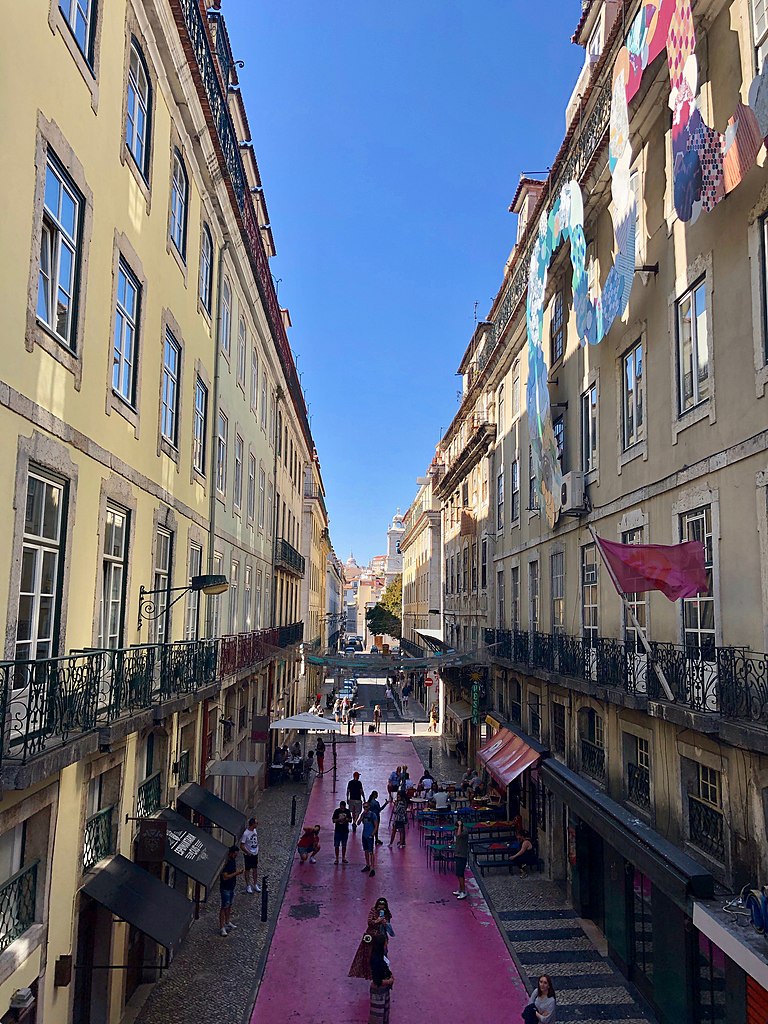
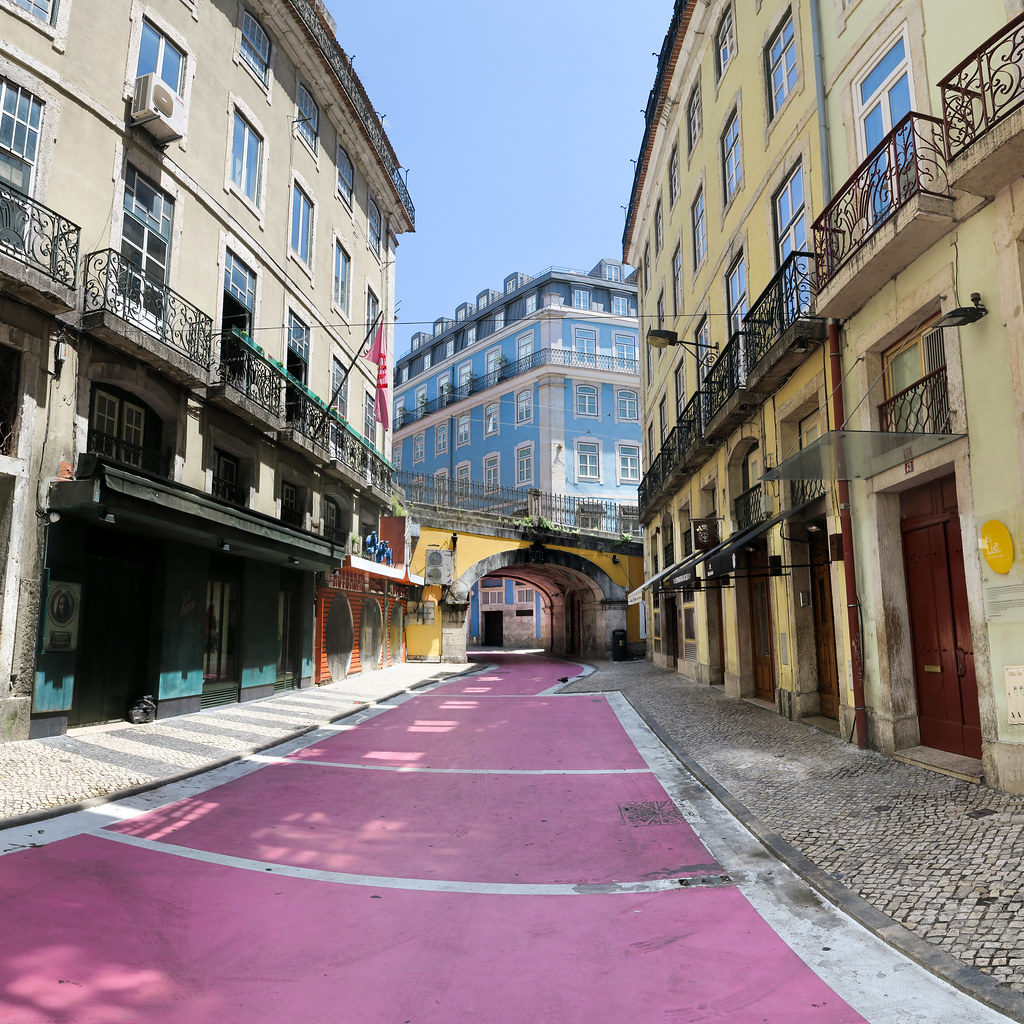
(right) Photo by Panoramas from flickr
Pink Street is a pedestrianized street located on the eastern edge of Lisbon’s Historic Center. The street is paved in a unique bright pink color, in direct contrast with all of the other streets within the city. The pink color was added in 2013, as a way to help popularize the area. The street itself is lined primarily with bars and it’s one of Lisbon’s most popular destinations for nightlife. Large crowds can be seen in the bars and along the street while enjoying some drinks and the lively atmosphere of modern-day Lisbon.
Neighborhoods of Lisbon
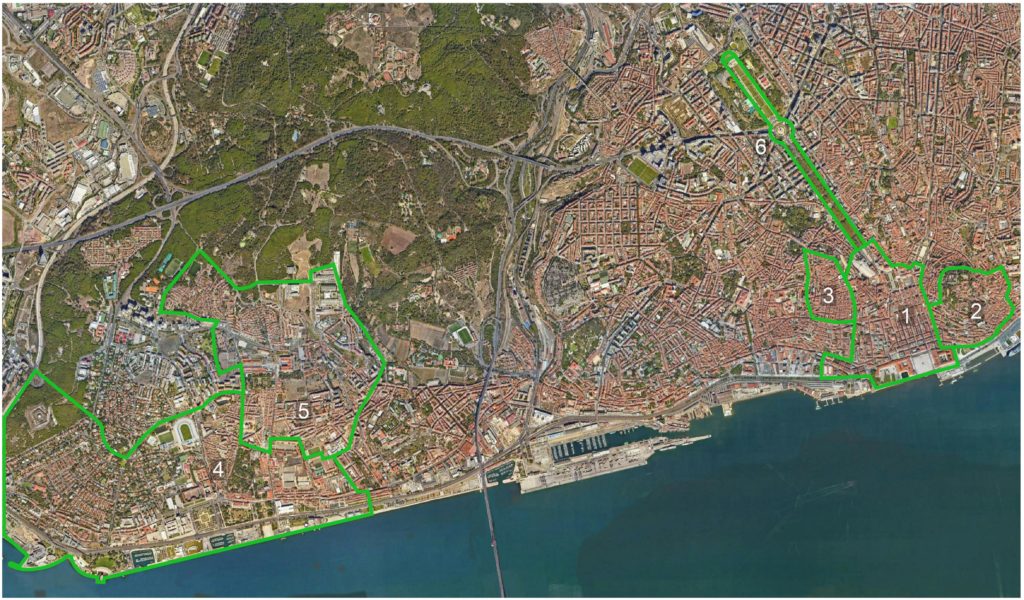
Map of Lisbon Showing the extents of various neighborhoods within the city
.

1. Baixa
The Baixa Neighborhood is the area within the city that was most devastated by the tragic Great Lisbon Earthquake of 1755. At that point, most of Lisbon’s historic center was destroyed, and a new plan was drawn to rebuild the area. Today some of Lisbon’s greatest works of architecture can be found here, such as the Praça do Comércio and Rossio Square.
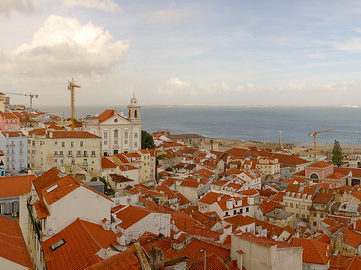
2. Alfama
Alfama is one of the oldest neighborhoods within Lisbon, and it managed to survive the great quake of 1755. Unlike the Baixa, Alfama is a jumble of windy medieval streets lined with historic buildings. Alfama contains some of the oldest architecture within Lisbon, such as remnants of the Medieval Walls, Lisbon Cathedral, and Saó Jorge Castle.
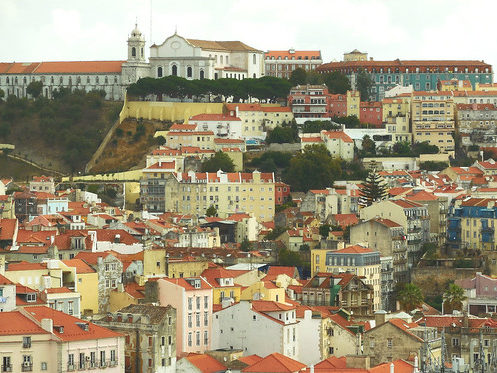
3. Bairro Alto
Bairro Alto is another one of Lisbon’s most important neighborhoods. It is located to the East of the Baixa, and it contains a blend of buildings from before and after the quake. It is also a mixed-use neighborhood, filled with residential buildings in addition to some of Lisbon’s greatest retail locations, and restaurants.

4. Belém
Belém is a district of Lisbon, located a few miles to the East of the Historic Center. It survived much of the destruction of the 1755 earthquake, and it is therefore filled with some of the greatest examples of Medieval and Gothic Architecture in Lisbon. A few of the principal sights are the Tower of Belém, Jerónimos Monastery, and the Monument of the Discoveries.

5. Ajuda
Ajuda is a neighborhood of Lisbon located to the north of Belém. It’s much less dense than many of the other districts of Lisbon, and it is home to a lot of residential buildings, in addition to commercial and industrial complexes. Ajuda is also home to one of Lisbon’s greatest examples of Neoclassical Architecture, the Palace of Ajuda.

6. Parque Eduardo VII & Avenue da Liberdade
While not necessarily a separate Neighborhood within Lisbon, the Parque Eduardo VII and the adjacent Avenue da Liberdade are two of the most popular attractions within the city. Both are part of the long axis that connects with the Baixa Neighborhood. The Park is one of the city’s largest green spaces, and the avenue contains some of the most high-end retail stores in all of Lisbon.
Architecture of Lisbon: In Review
Lisbon is one of those cities where history and architecture are directly correlated with one another. Within Lisbon, you will find buildings from every major age in architecture. From the Romanesque Lisbon Cathedral to the Manueline Gothic Architecture found in the Belém neighborhood, to the Baroque National Pantheon and Estrella Basilica. By far the most important event that left its mark on the Architecture of Lisbon was the massive earthquake that struck the city in 1755. This disaster killed thousands and left most of Lisbon’s History Center in ruins. But, from the ashes of the destruction came the new Baixa Neighborhood which stitched together and repaired the heart of Lisbon. Today Lisbon is a thriving city and the capital of one of Europe’s most visited nations.
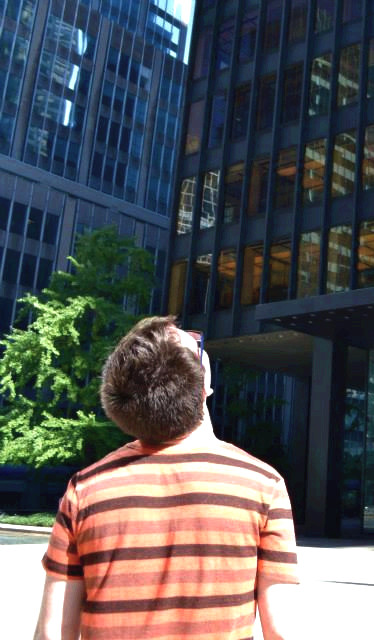
- About the Author
- Rob Carney, the founder and lead writer for Architecture of Cities has been studying the history of architecture for over 15 years.
- He is an avid traveler and photographer, and he is passionate about buildings and building history.
- Rob has a B.S. and a Master’s degree in Architecture and has worked as an architect and engineer in the Boston area for 10 years.
Like Architecture of Cities? Sign up for our mailing list to get updates on our latest articles and other information related to Architectural History.
